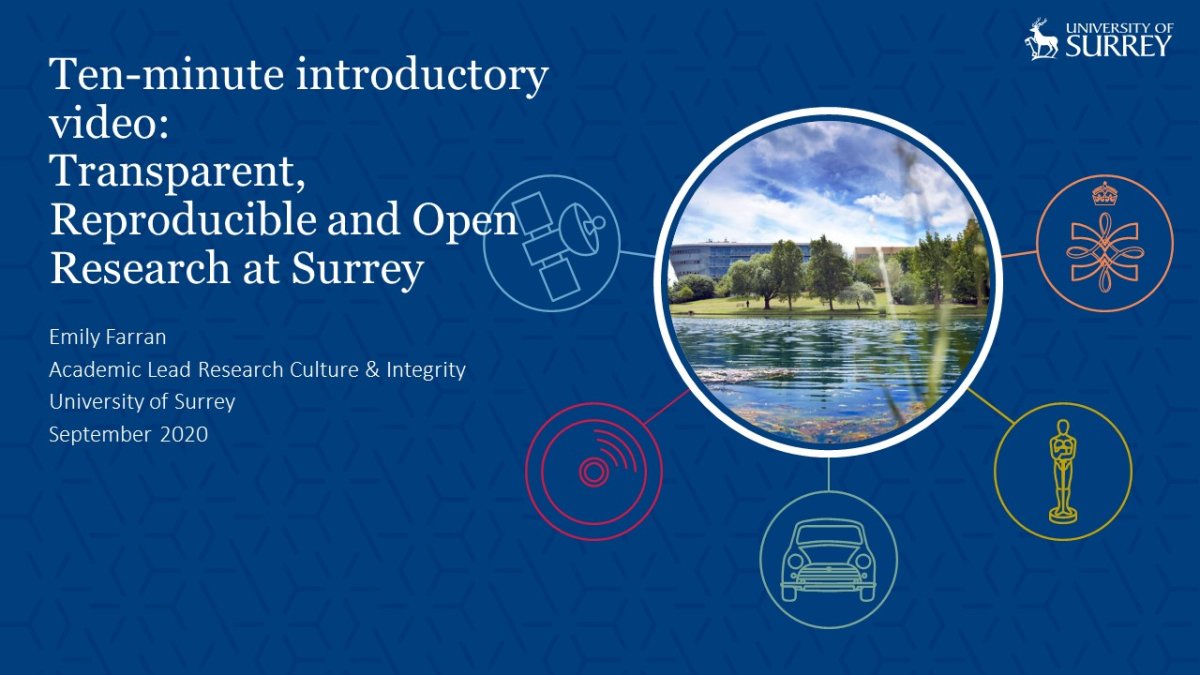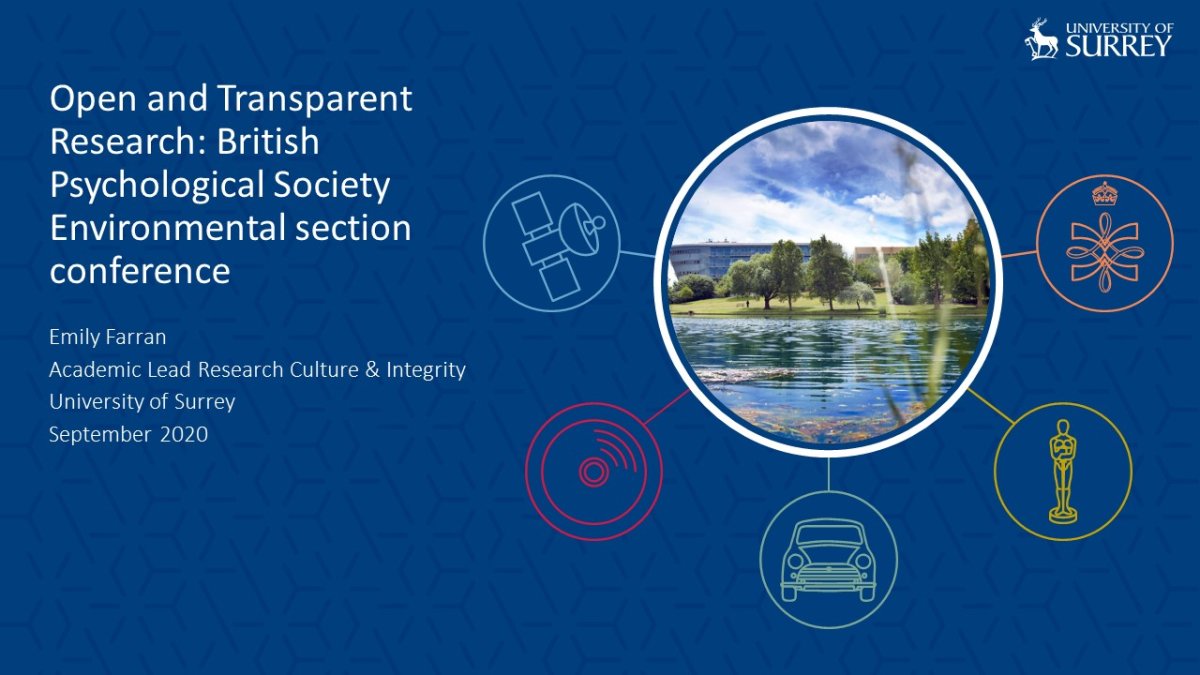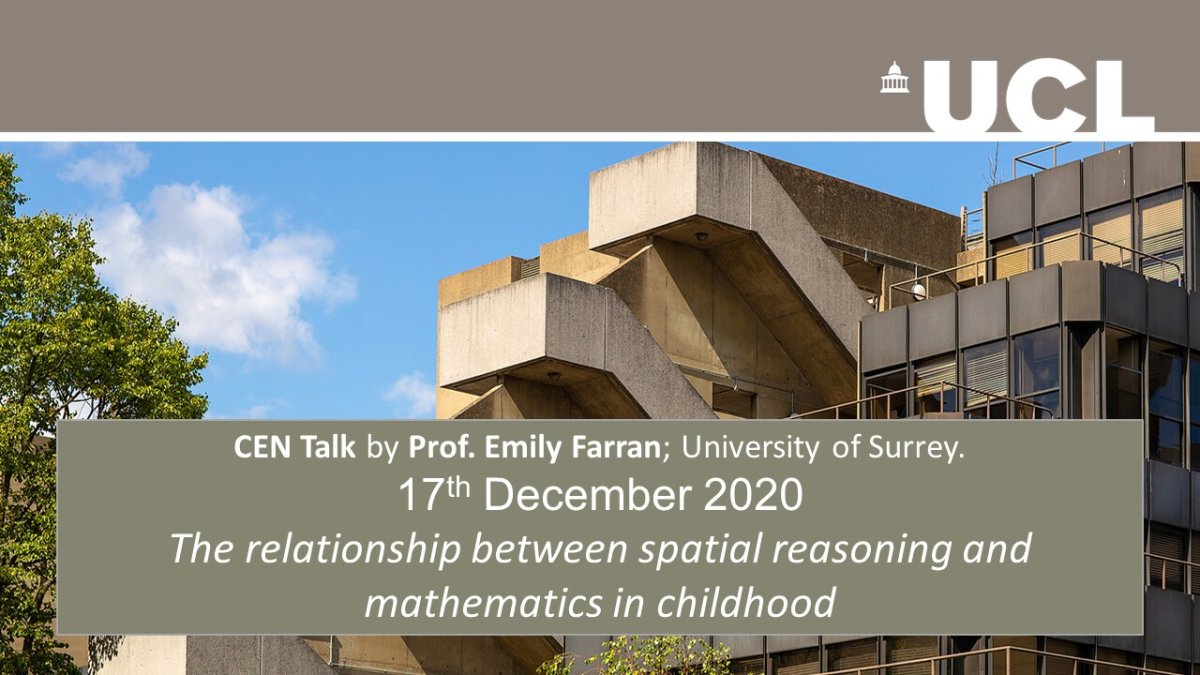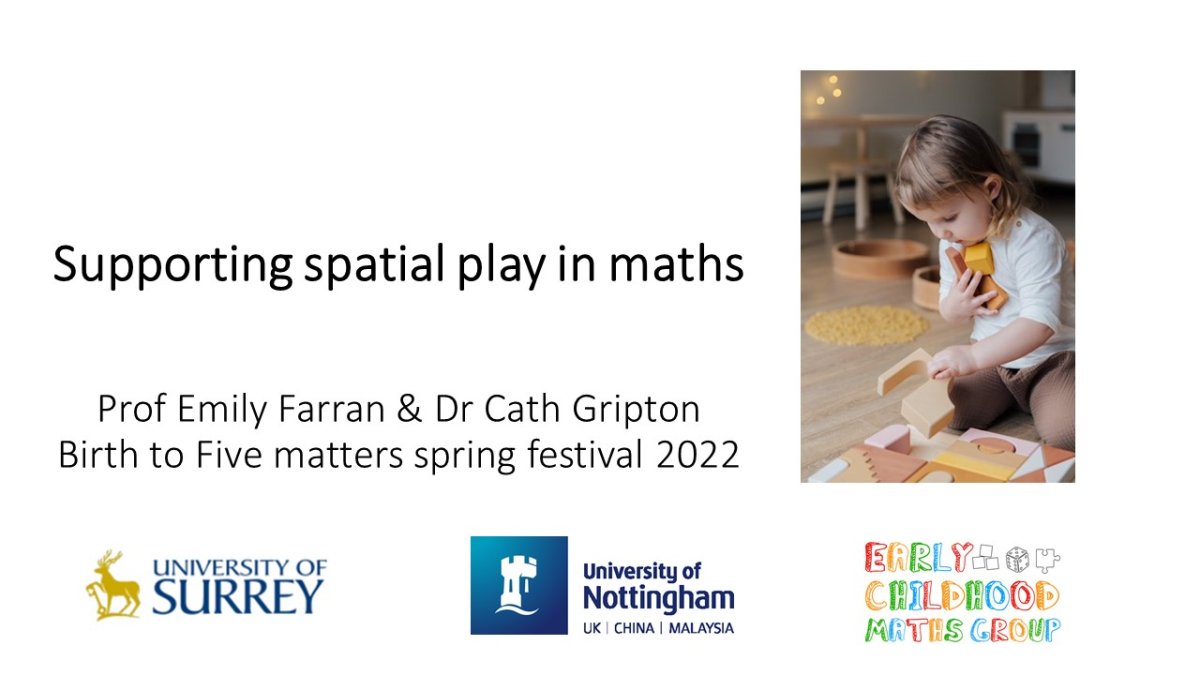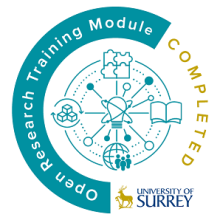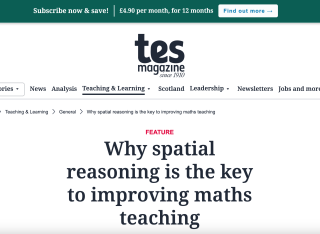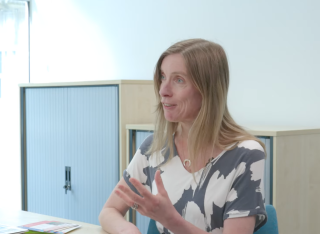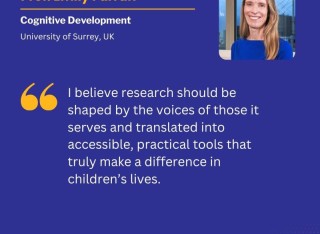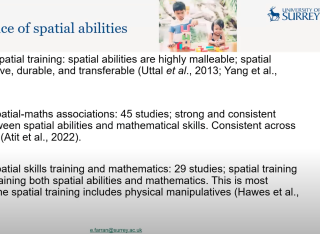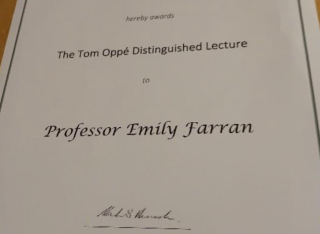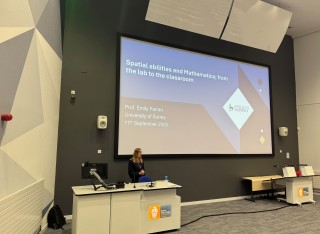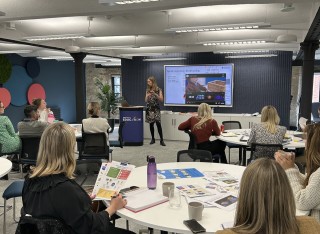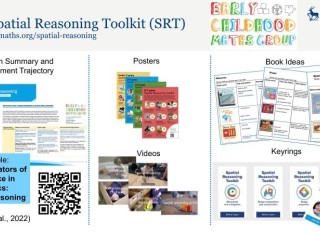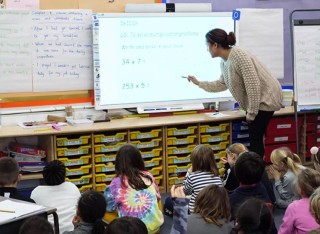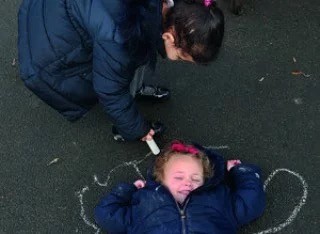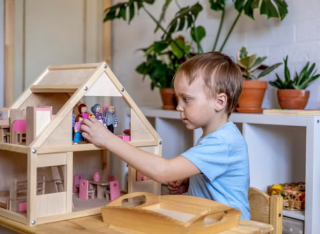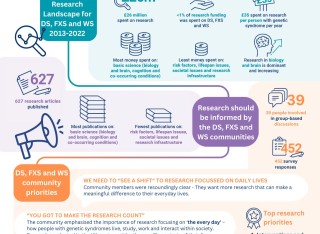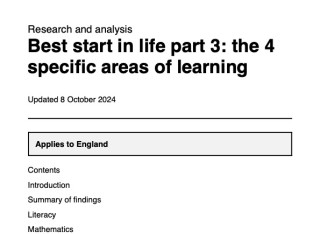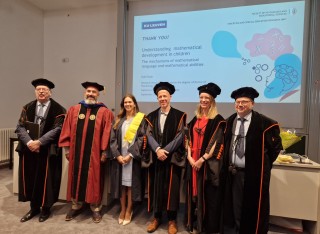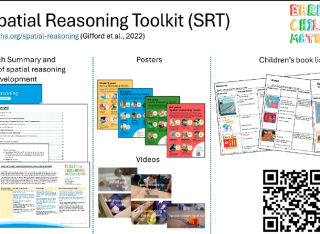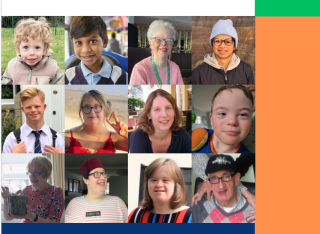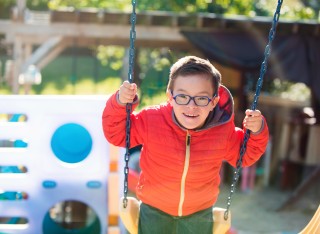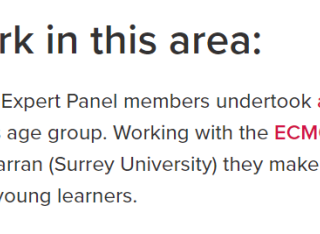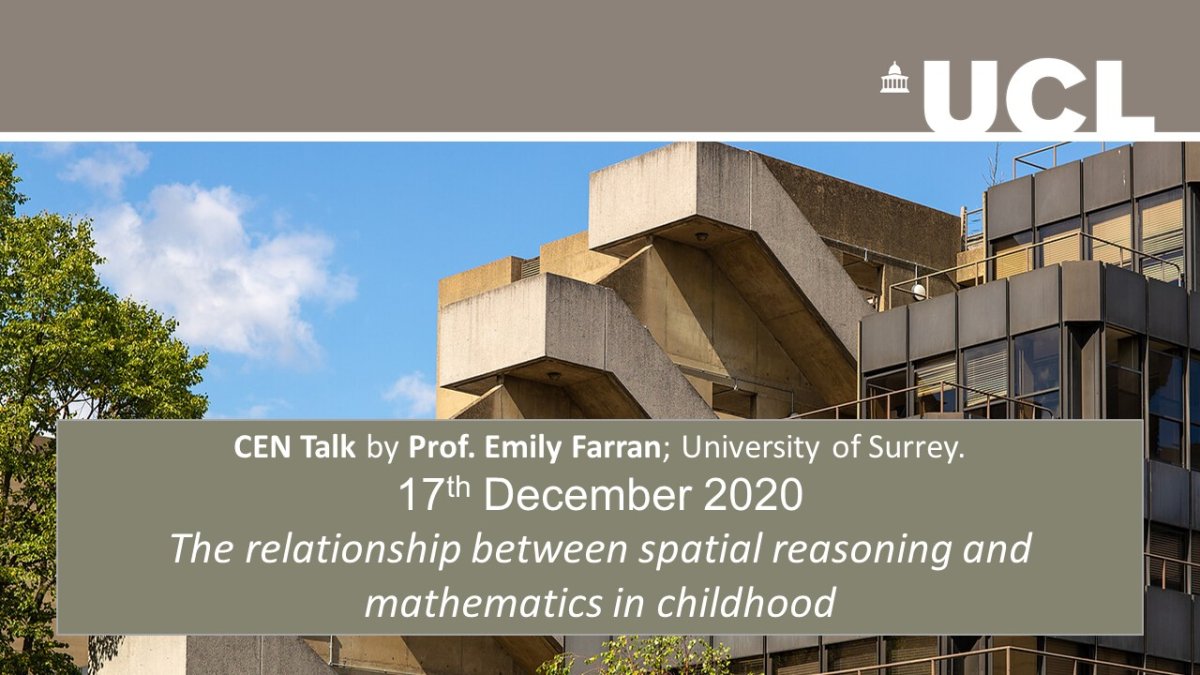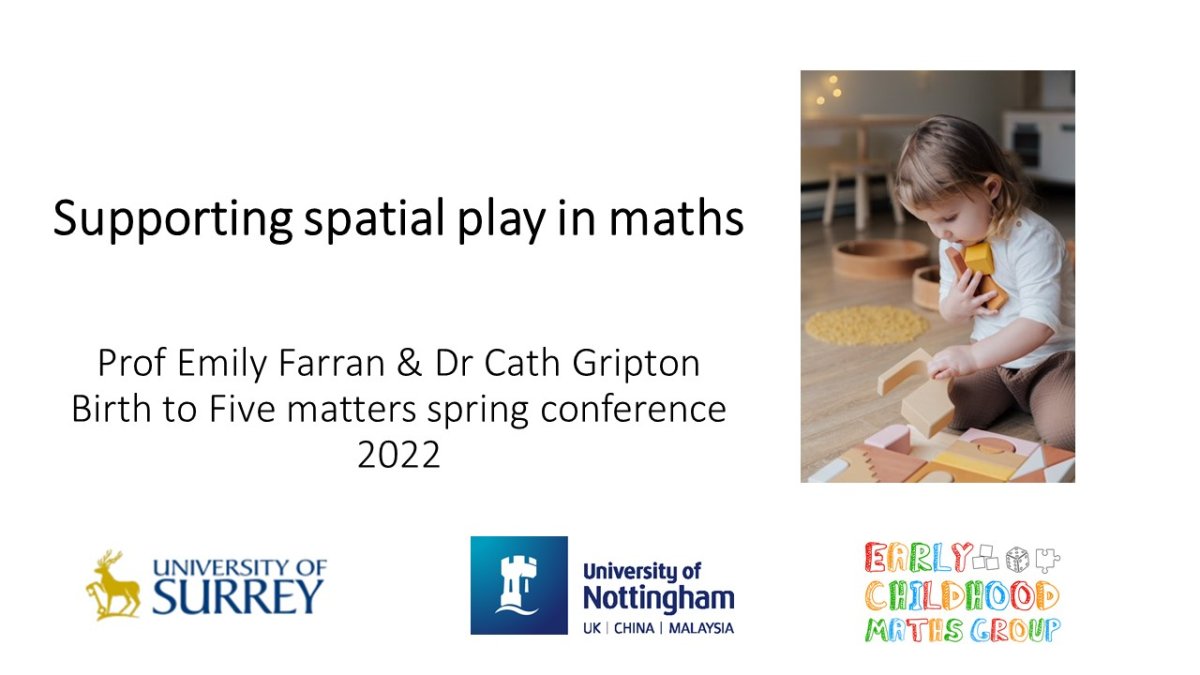
Professor Emily Farran
Academic and research departments
School of Psychology, Developmental Psychology Research Group, Cognition, Genes and Developmental Variability Lab, Faculty of Health and Medical Sciences.About
Biography
I am a Professor of Cognitive Development, at the University of Surrey, UK, where I direct the Cognition, Genes & Developmental Variability Lab. I completed my PhD at the University of Bristol in 2001. I then took on a lectureship position at the University of Reading. I then moved to the UCL Institute of Education in 2008, before joining the University of Surrey in 2018. The broad aim of my research is to characterise typical and atypical development of cognitive functions within the context of the developing brain. This includes a focus on the relationship between spatial thinking and Science and Mathematics achievement. I was awarded the 2024 Impact and Engagement award from the Developmental Psychology section of the British Psychological Society. My research has been funded by the Economic and Social Research Council, the British Academy, the Leverhulme Trust, the Nuffield Foundation, Wellcome, the Education Endowment Foundation, the Waterloo Foundation, Autour des Williams, the Williams Syndrome Foundation, and Fondation Jerome Lejeune.
Business, industry and community links
News
In the media
ResearchResearch interests
I am the Director of the Cognition, Genes and Developmental Variability lab. I am interested in spatial cognition in typical and atypical populations. My current research in typically developing children, and individuals with Autism, Down syndrome, Williams syndrome, Attention Hyperactivity Disorder, and Developmental Coordination Disorder includes the areas of navigation, motor performance, mental imagery, spatial language, perceptual integration, visuo-spatial memory and orientation coding. My most recent research interest relates to the relationship between spatial thinking and Science Technology Engineering and Maths (STEM) in primary school age children.
I am an advocate for open research. My efforts formed an integral part to the University of Surrey joining the UK Reproducibility Network in December 2019. This was coupled with my appointment as Academic Lead for Research Integrity and Culture in November 2019.
My research has been funded by the Economic and Social Research Council, the British Academy, the Leverhulme Trust, the Nuffield Foundation, the Wellcome Trust, the Education Endowment Fund, the Waterloo Foundation, Autour des Williams, the Williams Syndrome Foundation, and Fondation Jerome Lejeune.
For a full list of research projects in the lab, click here
If you are interested in studying for a PhD with me, please get in contact.
Research projects
SPACE stands for Spatial Cognition to Enhance Mathematical Learning. In this study, researchers from the University of Surrey, Loughborough University, University College Dublin and Birkbeck (the SPACE team) are using LEGO® to train spatial skills. An independent evaluation team from the Centre of Evidence & Implementation (CEI) will assess whether the SPACE programme is effective and feasible for teachers to deliver in Year 2 maths lessons. This project is funded by the Education Endowment Foundation.
BLOCS stands for Block Construction Skills for Mathematics. We are a group of researchers from the University of Surrey and Loughborough University working together to determine how LEGO® is related to and can be used to improve maths achievement in 7- to 9-year-olds. This research is funded by The Leverhulme Trust.
Enhancing and supporting the use of spatial thinking activities in the classroom is an inexpensive way of supporting children’s mathematical development, and can reduce the annual cost of mathematical difficulties to the UK. In project, we have collaborated with the Early Childhood Maths Group, a UK based group of early years mathematics practitioners and experts, to determine opportunities for adding spatial thinking to the curriculum and how best to translate spatial-maths research to teachers for maximum uptake. This culminated in creating a spatial reasoning toolkit for practitioners.
Spatial reasoning toolkit: Click here to view our spatial reasoning toolkit. In collaboration with the Early Childhood Maths Group, we summarise recent international research into the development of spatial reasoning from birth to seven years of age and have developed this into a trajectory of early learning experiences. The toolkit, which also includes videos, posters and spatial book lists, aims to clarify the mathematics in early spatial experiences, suggesting what to emphasise in order to support the development of children’s spatial reasoning in sensitive, appropriate and playful ways.
UnLocke is a large-scale randomised control trial was funded by the Education Endowment Foundation and the Wellcome Trust in order to evaluate the efficiency of an innovative computer-based learning activity. The 'Stop and Think' intervention is designed to help children in Years 3 and 5 stop and think before tackling problems in science and maths. A friendly character, named Andy, poses tricky questions to three virtual game-show contestants who demonstrate correct and incorrect thinking. Children complete various tasks as if they are taking part in the game-show. The tasks have been carefully developed to meet the content of the national curriculum for each age group. 6672 children from Year 3 (7- to 8-year-olds) and Year 5 (9- to 10-year-olds) in 89 schools across England took part in the study. Pupils who participated in the programme made the equivalent of +1 additional month’s progress in maths and +2 additional months’ progress in science, on average, compared to children in the lessons-as-usual control group. Pupils who received ‘Stop and Think’ also made more progress than pupils in an ‘active’ control group. These results have high security: 4 out of 5 on the EEF padlock scale. Further development and evaluation of the ‘Stop and Think’ computer game is underway.
We are very excited to have been awarded funding from the Leverhulme Trust to investigate the development of face-processing strategies in children and adults with Williams syndrome and Down Syndrome. These genetic conditions are each characterised by a range of physical and psychological differences relative to the typical population, as well as often highly social personalities.
Infants, children and adults can be particularly interested in viewing faces, and research is starting to reveal how the processing mechanisms for these stimuli might be consistently different from that of typically developing children and adults. As in the typical population, however, we still have a lot to learn. For example, we know only a little about the critical characteristics for face judgements (e.g., what cues are we actually using to decide someone’s identity, emotional expression) and whether they might change as children with Williams syndrome and Down syndrome move towards adulthood. Investigating face processing in this group provides us with a special opportunity to unpack the contributions of things like social interest and experience with faces and maturation of critical aspects of the visual system, which are more closely intertwined in typically developing
Over 1% of the UK population are on the autistic spectrum. These individuals experience atypical social communication and interaction, the presence of repetitive, rigid behaviours and altered sensory experiences. In addition, the cognitive profile of autistic people differs to that of individuals without the condition. For example, it has been suggested that autistic people show a greater tendency to process the details within a visual scene, rather than the overall gist. Cognitive ability also varies hugely within the autistic community: from minimally-verbal individuals with profound intellectual impairment, to those who are verbally fluent with above average IQ. These cognitive differences impact greatly on all aspects of life for autistic people, yet there is currently no consensus on the mechanisms underpinning cognitive strengths and how these might be harnessed to promote learning.
The current project, funded by the ESRC (PI: Anna Remington) centres on one such cognitive difference: the propensity for cognitively able autistic people to take in more perceptual information at any one time, compared to non-autistic individuals. This increased perceptual capacity can confer both practical advantages (enhanced information processing) and disadvantages (susceptibility to distraction) depending on the specific situation.
We hypothesise that this superior perceptual capacity is a central aspect of autism - and can offer a target for intervention, and guide the search for the neurobiological mechanisms associated with autism. This research will be the first investigation of the universality and specificity of increased perceptual capacity in autism. The results will inform a new theoretical approach to the condition (or subgroups within it), and an accompanying shift in best practice for intervention.
Further, the research takes a participatory approach: with autistic and non-autistic researchers working together to ensure the findings have a meaningful impact on the lives of autistic people and their families.
Research interests
I am the Director of the Cognition, Genes and Developmental Variability lab. I am interested in spatial cognition in typical and atypical populations. My current research in typically developing children, and individuals with Autism, Down syndrome, Williams syndrome, Attention Hyperactivity Disorder, and Developmental Coordination Disorder includes the areas of navigation, motor performance, mental imagery, spatial language, perceptual integration, visuo-spatial memory and orientation coding. My most recent research interest relates to the relationship between spatial thinking and Science Technology Engineering and Maths (STEM) in primary school age children.
I am an advocate for open research. My efforts formed an integral part to the University of Surrey joining the UK Reproducibility Network in December 2019. This was coupled with my appointment as Academic Lead for Research Integrity and Culture in November 2019.
My research has been funded by the Economic and Social Research Council, the British Academy, the Leverhulme Trust, the Nuffield Foundation, the Wellcome Trust, the Education Endowment Fund, the Waterloo Foundation, Autour des Williams, the Williams Syndrome Foundation, and Fondation Jerome Lejeune.
For a full list of research projects in the lab, click here
If you are interested in studying for a PhD with me, please get in contact.
Research projects
SPACE stands for Spatial Cognition to Enhance Mathematical Learning. In this study, researchers from the University of Surrey, Loughborough University, University College Dublin and Birkbeck (the SPACE team) are using LEGO® to train spatial skills. An independent evaluation team from the Centre of Evidence & Implementation (CEI) will assess whether the SPACE programme is effective and feasible for teachers to deliver in Year 2 maths lessons. This project is funded by the Education Endowment Foundation.
BLOCS stands for Block Construction Skills for Mathematics. We are a group of researchers from the University of Surrey and Loughborough University working together to determine how LEGO® is related to and can be used to improve maths achievement in 7- to 9-year-olds. This research is funded by The Leverhulme Trust.
Enhancing and supporting the use of spatial thinking activities in the classroom is an inexpensive way of supporting children’s mathematical development, and can reduce the annual cost of mathematical difficulties to the UK. In project, we have collaborated with the Early Childhood Maths Group, a UK based group of early years mathematics practitioners and experts, to determine opportunities for adding spatial thinking to the curriculum and how best to translate spatial-maths research to teachers for maximum uptake. This culminated in creating a spatial reasoning toolkit for practitioners.
Spatial reasoning toolkit: Click here to view our spatial reasoning toolkit. In collaboration with the Early Childhood Maths Group, we summarise recent international research into the development of spatial reasoning from birth to seven years of age and have developed this into a trajectory of early learning experiences. The toolkit, which also includes videos, posters and spatial book lists, aims to clarify the mathematics in early spatial experiences, suggesting what to emphasise in order to support the development of children’s spatial reasoning in sensitive, appropriate and playful ways.
UnLocke is a large-scale randomised control trial was funded by the Education Endowment Foundation and the Wellcome Trust in order to evaluate the efficiency of an innovative computer-based learning activity. The 'Stop and Think' intervention is designed to help children in Years 3 and 5 stop and think before tackling problems in science and maths. A friendly character, named Andy, poses tricky questions to three virtual game-show contestants who demonstrate correct and incorrect thinking. Children complete various tasks as if they are taking part in the game-show. The tasks have been carefully developed to meet the content of the national curriculum for each age group. 6672 children from Year 3 (7- to 8-year-olds) and Year 5 (9- to 10-year-olds) in 89 schools across England took part in the study. Pupils who participated in the programme made the equivalent of +1 additional month’s progress in maths and +2 additional months’ progress in science, on average, compared to children in the lessons-as-usual control group. Pupils who received ‘Stop and Think’ also made more progress than pupils in an ‘active’ control group. These results have high security: 4 out of 5 on the EEF padlock scale. Further development and evaluation of the ‘Stop and Think’ computer game is underway.
We are very excited to have been awarded funding from the Leverhulme Trust to investigate the development of face-processing strategies in children and adults with Williams syndrome and Down Syndrome. These genetic conditions are each characterised by a range of physical and psychological differences relative to the typical population, as well as often highly social personalities.
Infants, children and adults can be particularly interested in viewing faces, and research is starting to reveal how the processing mechanisms for these stimuli might be consistently different from that of typically developing children and adults. As in the typical population, however, we still have a lot to learn. For example, we know only a little about the critical characteristics for face judgements (e.g., what cues are we actually using to decide someone’s identity, emotional expression) and whether they might change as children with Williams syndrome and Down syndrome move towards adulthood. Investigating face processing in this group provides us with a special opportunity to unpack the contributions of things like social interest and experience with faces and maturation of critical aspects of the visual system, which are more closely intertwined in typically developing
Over 1% of the UK population are on the autistic spectrum. These individuals experience atypical social communication and interaction, the presence of repetitive, rigid behaviours and altered sensory experiences. In addition, the cognitive profile of autistic people differs to that of individuals without the condition. For example, it has been suggested that autistic people show a greater tendency to process the details within a visual scene, rather than the overall gist. Cognitive ability also varies hugely within the autistic community: from minimally-verbal individuals with profound intellectual impairment, to those who are verbally fluent with above average IQ. These cognitive differences impact greatly on all aspects of life for autistic people, yet there is currently no consensus on the mechanisms underpinning cognitive strengths and how these might be harnessed to promote learning.
The current project, funded by the ESRC (PI: Anna Remington) centres on one such cognitive difference: the propensity for cognitively able autistic people to take in more perceptual information at any one time, compared to non-autistic individuals. This increased perceptual capacity can confer both practical advantages (enhanced information processing) and disadvantages (susceptibility to distraction) depending on the specific situation.
We hypothesise that this superior perceptual capacity is a central aspect of autism - and can offer a target for intervention, and guide the search for the neurobiological mechanisms associated with autism. This research will be the first investigation of the universality and specificity of increased perceptual capacity in autism. The results will inform a new theoretical approach to the condition (or subgroups within it), and an accompanying shift in best practice for intervention.
Further, the research takes a participatory approach: with autistic and non-autistic researchers working together to ensure the findings have a meaningful impact on the lives of autistic people and their families.
Supervision
Postgraduate research supervision
I'm always looking for excellent PhD students to join my lab. If you’re interested in investigating spatial cognition and related functions, don’t hesitate to contact me about upcoming PhD research projects.
I currently supervise:
- Emma Campbell (ESRC 1+3 funded) 2014-2024 (includes 4 maternity leaves)
- Lauren Jenner (Cerebra / University of Surrey studentship) 2020-2024
- Gloria Yoshkova (EPSRC funded with support from the Williams Syndrome Foundation) 2022-2026
- Sarah McCarthy 2023-2030 (part time)
Completed postgraduate research projects I have supervised
- Chiraz Bensaad (ESRC funded 1+3) 2002-2008 (includes 2 maternity leaves)
- Kerry Hudson (CASE ESRC funded 1+3) 2006 –2011
- Susie Formby (University of Reading 1+3 studentship) 2006 -2011
- Joanne Camp (Bloomsbury +3 studentship) 2010 -2014
- Hannah Broadbent (CASE ESRC funded +3) 2010-2014 (includes 1 maternity leave)
- Jamie Lingwood (ESRC funded +3) 2011-2014
- Katie Gilligan (Bloomsbury studentship) 2015-2018
- Alex Hodgkiss (ESRC funded +3) 2015-2018
- Su Morris (Bloomsbury studentship) 2015-2020 (includes two secondments)
- Kathryn Bates (ESRC funded 1+3) 2016-2021 (includes COVID extension)
- Leighanne Mayall (CASE ESRC funded +3) 2015-2021 (part-time)
- Olatz Ojinaga alfageme (Bloomsbury studentship) 2018-2022
Publications
Little is known about how parental spatial language input relates to children's spatial cognition or mathematics performance or how children's own spatial language develops. The current study examined spatial language at 24 months (N = 187 families; 105 boys) and 48 months (N = 115 families; 66 boys), and spatial cognition and number performance at 48 months. Child spatial language was predominantly from the categories of " deictics, " " location and direction, " " continuous amount " and " spatial dimensions " at both timepoints. The diversity of par-ents' spatial language (spatial language quality) at 24 months was longitudinally associated with child numeracy at 48 months. Findings are discussed in relation to existing literature.
“Data sharing” describes the process of making research data available for reuse. The availability of research data is the basis of transparent, effective research systems that democratize access to knowledge and advance discovery. Despite a broad recognition of the value of data sharing across the sector, many researchers are not yet engaging meaningfully with data-sharing behaviors. Through a behavioral lens, in this qualitative Registered Report, we aimed to identify the barriers and enablers to data sharing experienced by researchers working at a UK university. Data were collected using a theoretically informed 26-item interview schedule (capability, opportunity, motivation–behavior [COM-B] model; theoretical-domains framework [TDF]). Fourteen participants across a range of career levels and disciplines were recruited to take part in semistructured interviews focused on data-sharing behaviors and their influences. Transcripts were analyzed using thematic template analysis based on the COM-B constructs and TDF domains. Results indicated that quantitative data-sharing behaviors were performed differently to qualitative behaviors, which affected the required skills. However, the barriers experienced were similar across all disciplines. These barriers included a lack of time to undertake data-sharing activities, concerns over General Data Protection Regulation/correct deidentification of data, and limited infrastructure. Enablers included researchers’ drive to be seen as open researchers. This identity matters to them for both the good of research and what it signals about them. It is a key enabling factor, potentially driving behavior even in the absence of other factors. Mandating data-sharing activities could encourage more widespread behaviors. However, such mandates need to be both discipline-specific and supported by institutions providing adequate resources.
Block construction performance is related to mathematics and block construction training leads to improvement in mathematics. However, block construction is a complex task, and it is unknown which aspects drive the associations between spatial skills and mathematics. Here, we deconstruct block-building behavior into three dimensions of accuracy, and the time spent building the models (build time). The data examined originated from structured LEGO® construction trials from N = 420 7- to 9-year-olds in the UK. The aim was to better understand the pattern of block-building behaviors in this age range, to investigate individual differences in block-building strategies, and to determine the association between these behaviors and a suite of spatial and mathematical abilities. Translation accuracy, the ability to place bricks on the correct pips of the bricks in the row below, was the most challenging block-building behavior. Investigation of block-building strategies demonstrated homogeneity in task approach strategy across the sample. Translation accuracy and build time tapped into two key spatial skills, disembedding and mental rotation, and were important for mathematics. Rotation accuracy, the ability to place bricks in the correct orientation, was related to mental rotation only. These findings have implications for future block construction interventions. A focus on translation accuracy could engender maximum transfer to mathematics.
School-based educational interventions have garnered significant attention due to their economic and developmental benefits. However, challenges and solutions for conducting intervention research in school settings, specifically when the intervention is delivered by school staff, remain underexplored. This paper aims to provide detailed guidance and recommendations for conducting school-delivered intervention research. An existing intervention development framework is described and adapted to the current context, and the Block Construction Skills for Mathematics (BLOCS) study is used as a case study to illustrate these processes and address the unique challenges encountered in school environments. The BLOCS study was conducted in primary schools in the United Kingdom and involved 7-to-8-year-olds and teachers. Insights were gathered from the research team's experiences, observations of the study's implementation and interviews with participating teachers, to identify challenges and develop practical solutions. The translation of research into practice is discussed, focusing on the development and evaluation of educational interventions. Specific challenges identified include logistical constraints, maintaining fidelity to the intervention, and fostering collaboration between researchers and school staff. Strategies to address these challenges were developed. The findings underscore the importance of flexible, adaptive approaches in conducting intervention research within schools. Practical recommendations are provided to guide researchers in overcoming common obstacles, ultimately supporting the successful implementation of educational interventions and enhancing their impact on students' development.
Smooth social interactions rely on children's abilities to decode others' social signals, which includes what an individual may say or do, and their facial emotional expressions. Failure can lead to exclusion from social groups. Consequently, a number of social and emotional learning (SEL) training programmes have been developed, with some evidence of positive impacts on those skills themselves and on academic achievement. Here, we present and evaluate the efficacy of a novel classroom-based computerized learning activity, called SEE+ (Socio-emotional engagement through observation), in supporting and enhancing 7- to 10-year-olds' emotion recognition and theory of mind judgements through observation and inference. SEE+ involved observing four virtual characters interacting within social scenarios and inferring their mental states. Participants were recruited from across diverse school settings (rural, urban) in England as part of a large-scale randomised controlled trial (n = 5585; 7.3-11.0 years old, M age = 9.1, SD = 1.0) resulting in a mix of socio-economic and ethnic backgrounds. Mixed model ANOVAs were used to compare performance on socio-emotional tasks between the SEE+ group, an active control group and a teaching-as-usual control group. SEE + was associated with the equivalent of 4-6 months improvement in performance on the socio-emotional assessment tasks. Children showed near transfer effects of the intervention (i.e., when characters present in the computerized learning activity were used in the assessment), while no strong evidence of far transfer effects (i.e., when photographs of unknown children were used in the assessment) was found. Limitations were the use of pen-and-paper assessments with a reduced number of trials, and a possible ceiling effect in the older children in the photograph condition. Our findings point to the relative plasticity of younger children's socio-emotional cognition and underscore SEE+ as an easy-to-use cost-effective socio-emotional resource for teachers to embed SEL in the school curriculum.
Data sharing describesthe process of making research data available for reuse. The availability of research data is the basis of transparent, effective research systems that democratise access to knowledge and advance discovery. Despite abroad recognition of the value of data sharingacross the sector, many researchers are not yetengagingmeaningfully with data sharingbehaviours. Through a behavioural lens, this qualitative Registered Reportaimedto identifythebarriers and enablersto data sharingexperiencedby researchers working ataUKuniversity.Data werecollected using atheoretically-informed 26-item interview schedule (COM-B model:Capability, Opportunity, Motivation –Behaviour;TDF: Theoretical Domains Framework). Fourteenparticipants,across a range of career levels and disciplines, wererecruited to take part in semi-structured interviews focused ondata sharingbehavioursand theirinfluences. Transcripts wereanalysed using thematictemplateanalysisbased ontheCOM-Bconstructsand TDFdomains.Results indicatedthat quantitative data sharing behaviours were performed differently to qualitative behaviours, which affected the required skills. However, the barriersexperienced were similar across all disciplines.These barriers included a lack of timeto undertake data sharing activities, concerns over GDPR/correct deidentification of data,and limited infrastructure.Enablers includedresearchers’driveto be seen as open researchers. This identity matters to them, both for the good of research and for what it signals about them. It is a key enabling factor, potentially driving behaviour even in the absence of other factors. Mandating data sharing activitiescould encourage more widespread behaviours.However,such mandates need to be both discipline specific and supported by institutions providing adequate resources
There is robust evidence for a causal association between spatial thinking and mathematics achievement. However, most research has been lab-based, with spatial training delivered by researchers. We present a teacher delivered, whole-class 6-week spatial training study that involved professional development for practitioners coupled with teacher-led LEGO® block construction training for 6- to 7-year-olds. Using a quasi-experimental design, N = 409 children completed the training and N = 103 children formed a business-as-usual control group. For spatial ability and mathematics, but not spatial language, children in the training condition showed improved performance relative to controls. This finding extends evidence of the positive effects of spatial training to an ecologically valid, classroom-based, practitioner-delivered context. The findings suggest that classroom opportunities to engage in block building using pictorial instruction are an effective activity for mathematics improvement. Our findings have implications for school curricula where spatial thinking is largely absent; a spatialized mathematics curriculum could raise children's mathematics attainment.
Navon hierarchical stimuli are designed to measure responses to the global level (grouped local elements, e.g. a forest) and the local level (individuated local elements, e.g. trees) of a visual scene. Cross-sectional evidence suggests that there are developmental changes in global and local processing. We examined global and local processing in 135 typically developing children in Year 1 (aged 5-6 year), Year 3 (aged 7-8 years), and Year 5 (aged 9-10 years). Participants completed a range of Navon tasks, each with different attentional demands. The design of the Navon stimuli remained constant across the tasks, ensuring that any task-related differences were not due to stimulus characteristics. Sixty children from Years 1 and 3 repeated the testing session two years later. Linear mixed model analyses combined longitudinal and cross-sectional data to assess developmental changes and the influence of attentional task demands on responses. The results revealed differing patterns of global and local processing responses according to Year group and attentional task demands. We found some evidence of developmental change in responses from a relatively more local advantage to a relatively more global advantage, which is consistent with the literature. However, the age at which this transition occurred varied across the tasks. We conclude that responses to hierarchical Navon stimuli are modulated by attentional task characteristics which mask any underlying global or local processing advantage.
Ensuring that knowledge generated through research has an impact on early childhood education practice is a familiar and complex challenge. This article reports on an attempt to bridge the research-practice divide in one area of mathematics, early spatial reasoning, through the development of a practitioner toolkit to aid professional learning. The approach was to research practitioner perspectives on what is needed to support practice in this important and often under-recognised area of mathematics. We conducted two questionnaires and three rounds of focus groups across three design cycles where the toolkit was expanded and adapted based on their feedback. Analysis of the data indicates that practitioners in England desire support in all areas of spatial reasoning, having received little or no training previously, and that multiple professional learning resources are required for a diverse sector. We argue that research dissemination, which is inclusive of the breadth of the early education sector, should provide age-range specific, accessible, practice-focussed, multi-modal resources.
Lab-based tasks suggest autistic people have increased perceptual capacity (i.e. process more information at any one time) compared to non-autistic people. Here, we explored whether this increase is reflected in autistic people's day-to-day perceptual experiences and, when compared to those with ADHD/neurotypical people, whether commonalities/divergences in these experiences can illuminate differences between neurotypes. UK-based adults (108 autistic, 40 with ADHD, 79 autistic with ADHD, 85 neurotypical) completed an online survey about experiences of attention and distraction. Responses were analysed using thematic analysis. We found that participants of all neurotypes experienced periods of intense focus. Neurodivergent participants reported experiencing a barrage of information; autistic participants found this overwhelming, whereas those with ADHD referred to overload. This finding may reflect increased perceptual capacity for autistic people (adding ecological validity to previous findings regarding increased autistic perceptual capacity) vs. difficulties maintaining attentional priorities for those with ADHD. While differences between neurodivergent and neurotypical people were evident, discrepancies between experiences of neurodivergent groups were more subtle, suggesting that increased perceptual capacity may extend beyond autism. Consequently, perceptual capacity offers a useful framework to promote better understanding of one's own perceptual experiences, and to guide strategies to ameliorate any challenges encountered.
Previous research demonstrates an association between spatial ability and science achievement in primary-school-aged children. However, little is known about the mechanisms driving this relationship. We investigated the associations between children’s spatial skills and components of physics learning (factual knowledge vs. conceptual knowledge [predictions and explanations]). Participants (N = 103; mean age = 9.6 years) completed a set of spatial tasks based on the “2 × 2” (intrinsic–extrinsic; static–dynamic) model of spatial cognition. They also participated in a whole-class science lesson about sound, followed by an assessment of science knowledge. After controlling for vocabulary and prior knowledge, spatial ability was not associated with factual knowledge scores. However, spatial skills were significantly associated with predictions and explanations; the association was stronger for explanations than for predictions and was driven by intrinsic–dynamic spatial skills. Findings demonstrate that spatial skills are more important for conceptual scientific knowledge than for factual scientific knowledge and further suggest that spatial intervention studies designed to enhance children’s science learning should target intrinsic–dynamic spatial skills.
This paper explores the views of early years teachers who were ‘early adopters’ of a revised assessment framework for children aged 4–5 years in England (2020–21). Based on interviews with four teachers and a survey involving 58 early adopters (part of a larger sample), the paper examines how these teachers have adapted their practice in mathematics in response to the reforms. It is argued that existing frames of understanding of good practice, drawn from external maths schemes and previous guidance, guide the enactment of the revised framework, suggesting a layering-over of new and past policies. This policy sedimentation, as we describe it, reduces the significance of the reforms, assuaging to some extent the concerns raised by maths specialists relating to the impact on children’s mathematical and spatial development. These findings provide further insights into the enactment of policy among early childhood educators.
There is a complex pattern of sex differences in spatial abilities, yet there is limited knowledge of sex differences in children's exposure to, and children's use of, spatial language. The aim of this study was to directly compare mother-child and father-child interactions to investigate differences by child and parent sex in spatial language. The first 3-min of mother-child and father-child DUPLO® play sessions were coded for spatial language when the child was 24 months (N = 187 families; 105:82 boys:girls) and two years later at 48 months (N = 115 families; 66:49 boys:girls). There were no sex differences in children's or parents' spatial language use at 24 months or 48 months. Regardless of socioeconomic status or parent talkativeness, parents showed more variety of spatial language (quality) with their daughters than their sons, but a similar quantity of spatial language with their daughters and sons. Associational analyses revealed a concurrent association between parent and child spatial language use at 48 months, but parent spatial language at 24 months did not predict child spatial language 2 years later. No direct sex effects were observed for cross-sectional or longitudinal associational analyses. Higher spatial language quality with daughters could reflect a higher (perceived) need to provide conceptual support to daughters than sons. Beyond this, we found limited evidence of sex effects. Our findings represent an important contribution, demonstrating comparable levels of exposure to spatial language to sons and daughters, and comparable elicitation of spatial language from young boys and girls. •Limited knowledge of sex differences in child exposure to/use of spatial language.•First study to compare mother-child and father-child interactions (24m and 48m).•Parents showed more variety of spatial language with daughters than sons.•Comparable levels of exposure to/use of spatial language for young boys and girls.•Concurrent association between parent and child spatial language use.
There is convincing evidence that training spatial abilities leads to improved mathematics performance in typically developing (TD) children. However, a lack of information on mathematical development and spatial–mathematical associations in people with Down syndrome (DS) hinders the translation of these interventions. Here, we established developmental trajectories of mathematics and explored whether spatial ability predicts attainment on different mathematics measures in individuals with DS. Participants with DS (n = 36; ages 9–35 years) and TD children (n = 132; ages 4–11 years) completed three groups of tasks: spatial tasks assessing different subdomains of spatial thinking; mathematics tasks assessing early mathematics skills, mathematical reasoning, arithmetic, and geometry; and IQ tasks. The developmental trajectories of mathematics performance against mental age revealed similar starting points of the trajectories and similar rates of development for DS and TD groups. Furthermore, after controlling for verbal skills, spatial skills explained 5.8% to 18.1% of the variation in mathematical performance across different mathematics tasks, and the pattern of spatial–mathematical relations was similar for DS and mental age-matched TD groups. This shows that mathematical development in DS groups appears to mirror that in TD children, indicative of delay only. Strong spatial–mathematical relations were observed for individuals with DS, like those seen for TD participants. This is the vital preliminary knowledge needed to support the design and use of spatial intervention for improving mathematics in individuals with DS.
Background Autistic people without intellectual disabilities have increased perceptual capacity: they can process more information at any given time compared to non-autistic people. We examined whether increased perceptual capacity is evident across the autistic spectrum (i.e. for autistic people with intellectual disabilities) and whether it is specific to autism, or also experienced by people with Williams Syndrome (WS). Methods Five autistic adults with intellectual disabilities and five adults with WS took part in accessible, qualitative interviews. Responses were analysed using thematic analysis. Results Both groups expressed enjoyment of focussed attention, with autistic participants preferring multiple simultaneous inputs. Responses suggested increased perceptual capacity for autistic participants only. The sensory environment was reported to be anxiety-inducing for both groups. Conclusions This study gives preliminary evidence that increased perceptual capacity may be universal across the autistic spectrum, and specific to autism. Understanding differences in capacity offers more targeted suggestions to support sensory challenges.
We know little about the ability to explore and navigate large-scale space for people with intellectual disabilities (ID). In this cross-syndrome study, individuals with Down syndrome (DS), individuals with Williams syndrome (WS) and typically developing children (TD; aged 5–11 years) explored virtual environments with the goal of learning where everything was within the environment (Experiment 1) or to find six stars (Experiment 2). There was little difference between the WS and DS groups when the goal was simply to learn about the environment with no specific destination to be reached (Experiment 1); both groups performed at a level akin to a subset of TD children of a similar level of non-verbal ability. The difference became evident when the goal of the task was to locate targets in the environment (Experiment 2). The DS group showed the weakest performance, performing at or below the level of a subset of TD children at a similar level of non-verbal ability, whilst the WS group performed at the level of the TD subset group. The DS, WS and TD group also demonstrated different patterns of exploration behavior. Exploration behaviour in DS was weak and did not improve across trials. In WS, exploration behavior changed across trials but was atypical (the number of revisits increased with repeated trials). Moreover, transdiagnostic individual difference analysis (Latent Profile Analysis) revealed five profiles of exploration and navigation variables, none of which were uniquely specific to DS or to WS. Only the most extreme profile of very poor navigators was specific to participants with DS and WS. Interestingly, all other profiles contained at least one individual with DS and at least one individual with WS. This highlights the importance of investigating heterogeneity in the performance of individuals with intellectual disability and the usefulness of a data-driven transdiagnostic approach to identifying behavioral profiles.
Background Relatively little is known about social cognition in people with intellectual disability (ID), and how this may support understanding of co-occurring autism. A limitation of previous research is that traditional social-cognitive tasks place a demand on domain-general cognition and language abilities. These tasks are not suitable for people with ID and lack the sensitivity to detect subtle social-cognitive processes. In autism research, eye-tracking technology has ofered an efective method of evaluating social cognition—indicating associations between visual social attention and autism characteristics. The present systematic review synthesised research which has used eye-tracking technology to study social cognition in ID. A meta-analysis was used to explore whether visual attention on socially salient regions (SSRs) of stimuli during these tasks correlated with degree of autism characteristics presented on clinical assessment tools. Method Searches were conducted using four databases, research mailing lists, and citation tracking. Following indepth screening and exclusion of studies with low methodological quality, 49 articles were included in the review. A correlational meta-analysis was run on Pearson’s r values obtained from twelve studies, reporting the relationship between visual attention on SSRs and autism characteristics. Results and conclusions Eye-tracking technology was used to measure diferent social-cognitive abilities across a range of syndromic and non-syndromic ID groups. Restricted scan paths and eye-region avoidance appeared to impact people’s ability to make explicit inferences about mental states and social cues. Readiness to attend to social stimuli also varied depending on social content and degree of familiarity. A meta-analysis using a random efects model revealed a signifcant negative correlation (r = −.28, [95% CI −.47, −.08]) between visual attention on SSRs and autism characteristics across ID groups. Together, these fndings highlight how eye-tracking can be used as an accessible tool to measure more subtle social-cognitive processes, which appear to refect variability in observable behaviour. Further research is needed to be able to explore additional covariates (e.g. ID severity, ADHD, anxiety) which may be related to visual attention on SSRs, to diferent degrees within syndromic and non-syndromic ID groups, in order to determine the specifcity of the association with autism characteristics. Keywords Eye-tracking, Social cognition, Intellectual disability, Genetic syndromes, Autism
The UNESCO Recommendations for Open Science define it as an inclusive framework that integrates movements and practices aimed at making multilingual scientific knowledge openly accessible, reusable, and collaborative for the benefit of science and society. This approach emphasizes transparency, collaboration, rigor, and accessibility, principles that align closely with qualitative research methodologies. In the health and social sciences, qualitative methods explore the meanings, experiences, and perspectives of individuals and groups. Open qualitative research encompasses diverse practices, including transparency in design and analysis, enabling meaningful scrutiny, and fostering collaboration through stakeholder engagement and co-production. The application of openness in qualitative research varies based on the context and specific project needs.
The nature of the home mathematics environment (which includes numerical and spatial activities at home) is related to children's spatial and mathematics performance. The current study investigated concrete and digital construction play frequency and relations with spatial and mathematical skills. Participants aged 7–9 years (N = 634) reported their frequency of construction play (concrete and digital) and completed direct measures of spatial ability and mathematics performance. Correlations between measures revealed no association between construction play frequency and outcome measures. This suggests that quantity of construction play is not pertinent for spatial and mathematics skills, however future research should explore whether quality of play is an important factor.
Given the developmental inter-relationship between motor ability and spatial skills, we investigated the impact of physical disability (PD) on spatial cognition. Fifty-three children with special educational needs including PD were divided into those who were wheelchair users (n = 34) and those with independent locomotion ability (n = 19). This division additionally enabled us to determine the impact of limited independent physical exploration (i.e., required wheelchair use) on spatial competence. We compared the spatial performance of children in these two PD groups to that of typically developing (TD) children who spanned the range of non-verbal ability of the PD groups. Participants completed three spatial tasks; a mental rotation task, a spatial programming task and a desktop virtual reality (VR) navigation task. Levels of impairment of the PD groups were broadly commensurate with their overall level of non-verbal ability. The exception to this was the performance of the PD wheelchair group on the mental rotation task, which was below that expected for their level of non-verbal ability. Group differences in approach to the spatial programming task were evident in that both PD groups showed a different error pattern from the TD group. These findings suggested that for children with both learning difficulties and PD, the unique developmental impact on spatial ability of having physical disabilities, over and above the impact of any learning difficulties, is minimal.
Evidence shows that spatial interventions are successful in typical development. However, the potential of spatial interventions for Down syndrome (DS) populations is hindered by the lack of literature on spatial skills and their development in this group. This paper investigates (a) the profile of strengths and weaknesses in spatial abilities, and (b) the cross-sectional developmental trajectories of spatial skills, in DS relative to typical development. Participants included 33 individuals with DS (58% male; 10–35 years) and 131 typically developing (TD) children (53% male; 4–11 years) who completed spatial tasks assessing two spatial sub-domains. Despite weaknesses in spatial skill, the DS spatial profile aligned closely with that of mental-age matched TD children. Cross-sectional developmental trajectories revealed slower rates of spatial development for those with DS, relative to TD children. Collectively, these results indicate potential for improving spatial skills in DS through intervention. •We created a battery of suitable spatial tasks for use with people with Down syndrome.•We investigated spatial profiles and development in people with Down syndrome.•Across spatial tasks, people with Down syndrome performed broadly similarly to mental-age matched groups.•Spatial development shows qualitative differences in people with Down syndrome.•Spatial skills have potential as an intervention target in people with Down syndrome.
Familiarity with technology has become a requirement for independent living, however there is limited information on technology access and use for people with Down syndrome (DS). The aim of this study is to describe technology, gaming, and social-media use in people with DS. Parents/caregivers (N = 220) of individuals with DS aged 5-35 years (49% female) completed an online questionnaire. They felt that technology and social media use, and to a lesser extent gaming, played an important role in their son/daughter's life. However, many had concerns about their son/daughter's safety online, and identified challenges they faced with using technology, such as using a mouse and speech recognition. We also found substantial parental interest in learning more about technology-use in DS, particularly the impact of using social media. This paper summarises important details about technology-use in people with DS, providing foundational information for the design of effective technology-based activities and support.
Spatial thinking predicts Science, Technology, Engineering and Mathematics achievement, yet is often absent from educational policy. We provide the first benchmarks of teachers’ usage and perceptions of spatial activities in practice in the reception classroom. Using a questionnaire study with educational professionals working in the reception (4-5 years) classroom in England (N=104), we found that spatial and numeracy activities were perceived as significantly less important, and were completed significantly less often, than literacy or life skills. Given the lack of focus on spatial skills in the curriculum guidance in England, rates of spatial activity use were encouragingly high and were broadly comparable to those of numeracy. Teachers’ anxiety levels were moderate for both spatial and mathematics domains. The findings highlight a need to elevate teacher’s understanding of the importance of developing children’s early spatial and numeracy skills, which may begin with efforts to reduce spatial and mathematics anxiety.
This paper reports the use and impact of the Spatial Reasoning Toolkit (SRT) a year after its launch.
Spatial thinking predicts Science, Technology, Engineering, and Mathematics achievement, yet is often absent from educational policy. We provide benchmarks of teachers' usage and perceptions of spatial activities in practice in the reception classroom (first year of primary school). In this questionnaire study of educational professionals working in the reception classroom in England (N = 104), we found that spatial and numeracy activities were perceived as significantly less important, and were reportedly completed significantly less often, than literacy or life skills. Despite the lower perceived importance of spatial skills in curriculum guidance in England, rates of reported spatial activity use were encouragingly high and were broadly comparable to those of numeracy. Teachers had moderate anxiety levels for both spatial and mathematics domains. The findings highlight a need to elevate teachers' understanding of the importance of developing children's early spatial and numeracy skills, which may begin with efforts to reduce spatial and mathematics anxiety.
Research shows that questionable research practices (QRPs) are present in undergraduate final-year dissertation projects. One entry-level Open Science practice proposed to mitigate QRPs is “study preregistration,” through which researchers outline their research questions, design, method, and analysis plans before data collection and/or analysis. In this study, we aimed to empirically test the effectiveness of preregistration as a pedagogic tool in undergraduate dissertations using a quasi-experimental design. A total of 89 UK psychology students were recruited, including students who preregistered their empirical quantitative dissertation (n = 52; experimental group) and students who did not (n = 37; control group). Attitudes toward statistics, acceptance of QRPs, and perceived understanding of Open Science were measured both before and after dissertation completion. Exploratory measures included capability, opportunity, and motivation to engage with preregistration, measured at Time 1 only. This study was conducted as a Registered Report; Stage 1 protocol: https://osf.io/9hjbw (date of in-principle acceptance: September 21, 2021). Study preregistration did not significantly affect attitudes toward statistics or acceptance of QRPs. However, students who preregistered reported greater perceived understanding of Open Science concepts from Time 1 to Time 2 compared with students who did not preregister. Exploratory analyses indicated that students who preregistered reported significantly greater capability, opportunity, and motivation to preregister. Qualitative responses revealed that preregistration was perceived to improve clarity and organization of the dissertation, prevent QRPs, and promote rigor. Disadvantages and barriers included time, perceived rigidity, and need for training. These results contribute to discussions surrounding embedding Open Science principles into research training.
There is evidence that spatial thinking is malleable, and that spatial and mathematical skills are associated (Mix et al. [2016] Journal of Experimental Psychology: General, 145, 1206; Mix et al. [2017] Journal of Cognition and Development, 18, 465; Uttal et al. [2013] Psychological Bulletin, 139, 352). However, few studies have investigated transfer of spatial training gains to mathematics outcomes in children, and no known studies have compared different modes of spatial instruction (explicit vs. implicit instruction). Based on a sample of 250 participants, this study compared the effectiveness of explicit and implicit spatial instruction in eliciting near transfer (to the specific spatial skills trained), intermediate transfer (to untrained spatial skills) and far transfer (to mathematics domains) at age 8. Spatial scaling and mental rotation skills were chosen as training targets as previous studies have found, and proposed explanations for, associations between these skills and mathematics in children of this age (Journal of Experimental Psychology: General, 145, 2016 and 1206). In this study, spatial training led to near, intermediate and far transfer of gains. Mental visualization and proportional reasoning were proposed to explain far transfer from mental rotation and spatial scaling skills respectively. For most outcomes, except for geometry, there was no difference in the effectiveness of implicit (practice with feedback) compared to explicit instruction (instructional videos). From a theoretical perspective, the study identified a specific causal effect of spatial skills on mathematics skills in children. Practically, the results also highlight the potential of instructional videos as a method of introducing spatial thinking into the classroom.
Individuals with the neurodevelopmental disorder Williams syndrome (WS) often report difficulty processing and acting in depth, such as crossing roads or reaching for objects; however little research attention has been directed at understanding depth perception and action in depth in WS and whether deficits in depth perception have an ocular or perceptual root in this group. This study assessed the extent and relationship of deficits in stereopsis (binocular, three dimensional vision) and actions performed in depth in WS, as well as in typically developing participants (TD) matched for non-verbal ability. Stereoacuity was age-appropriate in the TD group but at the level of a TD three year old in WS; one third of the WS group did not show evidence of stereopsis. When monocularly acting in depth there was no difference between the WS and TD groups. When binocularly acting in depth the WS group that did not exhibit stereopsis were significantly poorer than the TD group and the WS group that exhibited stereopsis. When assessing the relationship between stereoacuity and action in depth, stereoacuity negatively correlated with binocular action in depth for the WS group with stereopsis, but not the TD group. Therefore, no deficits in monocular depth perception in WS were evidenced, yet significant deficits are exhibited in binocular depth perception and action. Importantly action in depth under binocular viewing may be a useful gross screening measure for stereodeficits in WS. Remediation of depth perception deficits in WS could train further understanding of monocular cues to compensate for poor stereopsis.
Wayfinding is the ability to learn and recall a route through an environment. Theories of wayfinding suggest that for children to learn a route successfully, they must have repeated experience of it, but in this experiment we investigated whether children could learn a route after only a single experience of the route. A total of 80 participants from the United Kingdom in four groups of 20 8-year-olds, 10-year-olds, 12-year-olds, and adults were shown a route through a 12-turn maze in a virtual environment. At each junction, there was a unique object that could be used as a landmark. Participants were "walked" along the route just once (without any verbal prompts) and then were asked to retrace the route from the start without any help. Nearly three quarters of the 12-year-olds, half of the 10-year-olds, and a third of the 8-year-olds retraced the route without any errors the first time they traveled it on their own. This finding suggests that many young children can learn routes, even with as many as 12 turns, very quickly and without the need for repeated experience. The implications for theories of wayfinding that emphasize the need for extensive experience are discussed.
Facial expression recognition was investigated in 20 males with high functioning autism(HFA) or Asperger syndrome (AS), compared to typically developing individuals matched for chronological age (TD CA group) and verbal and non-verbal ability (TD V/NV group).This was the first study to employ a visual search, ‘‘face in the crowd’’ paradigm with aHFA/AS group, which explored responses to numerous facial expressions using real-face stimuli. Results showed slower response times for processing fear, anger and sad expressions in the HFA/AS group, relative to the TD CA group, but not the TD V/NV group. Reponses to happy, disgust and surprise expressions showed no group differences. Results are discussed with reference to the amygdala theory of autism.
Lego construction ability is associated with a variety of spatial skills and mathematical outcomes. However, it is unknown whether these relations are causal. We aimed to establish the causal impact of Lego construction training on: Lego construction ability; a broad range of spatial skills; and on mathematical outcomes in 7–9-year-olds. We also aimed to identify how this causal impact differs for digital versus physical Lego construction training. One-hundred and ninety-eight children took part in a six-week training programme, delivered twice weekly as a school lunch time club. They completed either physical Lego training (N = 59), digital Lego training (N = 64), or an active control condition (crafts; N = 75). All children completed baseline and follow-up measures of spatial skills (disembedding, visuo-spatial working memory, spatial scaling, mental rotation, and performance on a spatial-numerical task, the number line task), mathematical outcomes (geometry, arithmetic, and overall mathematical skills) and Lego construction ability. Exploratory analyses revealed evidence for near transfer (Lego construction ability) and some evidence for far transfer (arithmetic) of Lego training, but overall transfer was limited. Despite this, we identified key areas for further development (explicit focus on spatial strategies, training for teachers, and embedding the programme within a mathematical context). The findings of this study can be used to inform future development of Lego construction training programmes to support mathematics learning.
The ability to learn routes though a virtual environment (VE) and to make a novel shortcutbetween two locations was assessed in 18 adults with intellectual disability and 18 adults without intellectual disability matched on chronological age. Participants explored two routes (A,B and A,C) until they reached a learning criterion. Then, they were placed at B and were asked to find the shortest way to C (B, C, five trials). Participants in both groups could learn the routes, but most of the participants with intellectual disability could not find the shortest route between B and C. However, the results also revealed important individual differences within the intellectual disability group, with some participants exhibiting more efficient wayfinding behaviour than others. Individuals with intellectual disability may differ in the kind of spatial knowledge they extract from the environment and/or in the strategy they use to learn routes.
This introductory chapter first sets out the purpose of the book, which is to serve as a paradigm for multidisciplinary, neuroconstructivist approaches to a wide range of other syndromes, taking the neurodevelopmental disorder Williams syndrome (WS) as a model syndrome. It then discusses the neuroconstructivist approach to neurodevelopmental disorders. An overview of the subsequent chapters is also presented.
Nowadays, it is widely accepted that there is no single influence (be it nature or nurture) on cognitive development. Cognitive abilities emerge as a result of interactions between gene expression, cortical and subcortical brain networks, and environmental influences. In recent years, our study of neurodevelopmental disorders has provided much valuable information on how genes, brain development, behaviour, and environment interact to influence development from infancy to adulthood. This book presents evidence on development across the lifespan across these multiple levels of description (genetic, brain, cognitive, environmental). It chooses a well-defined disorder, Williams syndrome (WS), to explore the impact of genes, brain development, behaviour, as well as the individual's environment on development. WS is used as a model disorder to demonstrate the book's approach to understanding development, whilst being presented in comparison to other neurodevelopmental disorders - autism, developmental dyscalculia, Down syndrome, dyslexia, fragile X syndrome, Prader-Willi syndrome, Specific Language Impairment, Turner syndrome - to illustrate differences in development across neurodevelopmental disorders. WS is particularly informative for exploring development. Firstly, it has been extensively researched at multiple levels: genes, brain, cognition, and behaviour as well as in terms of the difficulties of daily living and social interaction. Secondly, it has been studied across the lifespan, with many studies on infants and toddlers with WS as well as a large number on children, adolescents, and adults. The book also explores a number of domain-general and domain-specific processes in the verbal, non-verbal, and social domains, across numerous neurodevelopmental disorders. This illustrates, among other factors, the importance of developmental timing, i.e., that the development of a cognitive skill at a specific timepoint can impact on subsequent development within that domain, but also across domains. In addition, the chapters discuss the value of investigating basic-level abilities from as close to the infant start-state as possible, presenting evidence of where cross-syndrome comparisons have shed light on the cascading impacts of subtle similarities and discrepancies in early delay or deviance, on subsequent development.
This chapter shows that executive functions and motor planning are impaired in Williams syndrome (WS). It assesses inhibition (such as inhibition of a prepotent response) and its influence on social functioning, and evaluates how the cascading developmental effects of poor planning ability impact on the wider functioning of other aspects of cognition such as performance on visuospatial tasks. It considers studies that have investigated the interplay between multiple executive functions to resolve the mixed evidence relating to executive dysfunction in WS. Motoric planning is discussed in terms of walking, stairdescent, and reaching studies that reveal evidence for poor motor planning in WS. The chapter highlights how the use of neuroimaging techniques and analysis of movement in real-world situations has advanced the understanding of executive function and motor planning in typical development as well as in groups with neurodevelopmental disorders including WS.
There is a known association between LEGO® construction ability and mathematics achievement, yet the mechanisms which drive this association are largely unknown. This study investigated the spatial mechanisms underlying this association, and whether this differs for concrete versus digital construction. Between January 2020 and July 2021, children aged 7–9 years (N = 358, 189 female, ethnicity not recorded) completed spatial and mathematics tasks, and either a concrete or digital Lego construction task. Mediation analyses examining direct and indirect pathways (through spatial skills) between Lego construction ability and mathematics explained 8.4% to 26.6% of variance in mathematics scores. Exploratory moderated mediation analyses revealed that only the indirect path through mental rotation differed between Lego conditions. Findings are discussed in relation to theories of spatial-numerical associations and the potential of Lego training for mathematics improvement.
n the typical population, a series of drawing strategies have been outlined, which progressively emerge during childhood. Individuals with Williams syndrome (WS), a rare genetic disorder, produce drawings that lack cohesion, yet drawing strategies in this group have hitherto not been investigated. In this study, WS and typically developing (TD) groups drew and constructed (from pre-drawn lines and shapes) a series of intersecting and embedded figures. Participants with WS made use of the same strategies as the TD group for simple intersecting figures, though were less likely to use a typical strategy for more complex figures that contained many spatial relations. When replicating embedded shapes, the WS group used typical drawing strategies less frequently than the TD group, despite attempting to initiate a strategy that is observed in TD children. Results suggested that individuals with WS show a particular difficulty with replicating figures that include multiple spatial relations. The impact of figure complexity and task demands on performance are discussed.
The Activity Theory-based Model of Serious Games (ATMSG) provides a visual framework through which designers and researchers can explicitly map the gaming, learning, and instructional design of their learning game mechanics and game flow. Here, we use the ATMSG to redesign an existing learning game, Stop &Think (S&T), which was created to train children to apply their inhibitory control skills when solving counterintuitive mathematics and science problems. S&T was previously found to be effective at increasing science and mathematics achievement when the activity was led by a teacher in the classroom. However, we sought to modify its design for use by children in an independent learning scenario (e.g., homeschooling). This work contributes to the literature by demonstrating how the ATMSG was used iteratively during the redesign of S&T for use in a child-led context. We found the ATMSG useful for (i) identifying design gaps created by removing the teacher from the gaming activity, thereby outlining areas of the game requiring modification, (ii) ideation to facilitate discussion about how different design ideas would impact the structure of the game and the feasibility of the approach, (iii) negotiating design decisions between team members, communicating proposed changes in the design amongst stakeholders, seeking approval from project leaders, and serving as a design document for developers, and (iv) cataloguing changes made to the game throughout the redesign process, thereby archiving versions of the game which can be used to reflect upon how each version might impact counterintuitive reasoning. Yet, we also found some challenges in using the ATMSG, including its lack of ability to represent non-structural design decisions (e.g., visual strategies, adaptivity), its impractical format for representing more complex games, and its time-consuming nature. [Display omitted] •Activity Theory-based Model of Serious Games enables detailed game descriptions.•Stop & Think is a learning game designed for use in a teacher-led classroom context.•We used the ATMSG to iteratively to redesign Stop & Think for a child-led context.•We discuss the advantages and challenges of applying the ATMSG in this process.•The article acts as an exemplar for the use of the ATMSG for game (re)design.
Mental imagery (MI) is the ability to generate visual phenomena in the absence of sensory input. MI is often likened to visual working memory (VWM): the ability to maintain and manipulate visual representations. How MI is recruited during VWM is yet to be established. In a modified orientation change-discrimination task, we examined how behavioral (proportion correct) and neural (contralateral delay activity [CDA]) correlates of precision and capacity map onto subjective ratings of vividness and number of items in MI within a VWM task. During the maintenance period, 17 participants estimated the vividness of their MI or the number of items held in MI while they were instructed to focus on either precision or capacity of their representation and to retain stimuli at varying set sizes (1, 2, and 4). Vividness and number ratings varied over set sizes; however, subjective ratings and behavioral performance correlated only for vividness rating at set size 1. Although CDA responded to set size as was expected, CDA did not reflect subjective reports on high and low vividness and on nondivergent (reported the probed number of items in mind) or divergent (reported number of items diverged from probed) rating trials. Participants were more accurate in low set sizes compared with higher set sizes and in coarse (45°) orientation changes compared with fine (15°) orientation changes. We failed to find evidence for a relationship between the subjective sensory experience of precision and capacity of MI and the precision and capacity of VWM.
This chapter discusses how a neuroconstructivist, multidisciplinary approach enriches our understanding of neurodevelopmental disorders. The neuroconstructivist approach raises cross-syndrome questions at multiple levels of analysis, such as: is this brain/cognitive/behavioural deficit syndrome-specific or is it syndrome-general, that is, is it characteristic of all atypical development where learning difficulties obtain or unique to a particular syndrome? It differentiates domain-relevant mechanisms from domain-specific or domain-general ones. It also searches for very low-level impairments in the neonate profile - at the levels of brain, cognition, and behaviour - that might affect gene expression and have cascading effects on developmental outcomes.
Individuals with Williams syndrome (WS) demonstrate impaired visuo-spatial abilities in comparison to their level of verbal ability. In particular, visuo-spatial construction is an area of relative weakness. It has been hypothesised that poor or atypical location coding abilities contribute strongly to the impaired abilities observed on construction and drawing tasks [Farran, E. K., & Jarrold, C. (2005). Evidence for unusual spatial location coding in Williams syndrome: An explanation for the local bias in visuo-spatial construction tasks? Brain and Cognition, 59, 159–172; Hoffman, J. E., Landau, B., & Pagani, B. (2003). Spatial breakdown in spatial construction: Evidence from eye fixations in children with Williams syndrome. Cognitive Psychology, 46, 260–301]. The current experiment investigated location memory in WS. Specifically, the precision of remembered locations was measured as well as the biases and strategies that were involved in remembering those locations. A developmental trajectory approach was employed; WS performance was assessed relative to the performance of typically developing (TD) children ranging from 4- to 8-year-old. Results showed differential strategy use in the WS and TD groups. WS performance was most similar to the level of a TD 4-year-old and was additionally impaired by the addition of physical category boundaries. Despite their low level of ability, the WS group produced a pattern of biases in performance which pointed towards evidence of a subdivision effect, as observed in TD older children and adults. In contrast, the TD children showed a different pattern of biases, which appears to be explained by a normalisation strategy. In summary, individuals with WS do not process locations in a typical manner. This may have a negative impact on their visuo-spatial construction and drawing abilities.
Objectives Motor difficulties are often reported in individuals with attention deficit hyperactivity disorder (ADHD). The aims of this study are to detail themotor profile of childrenwith ADHD and to determine whether themotor impairment present in a large proportion of children with ADHD represents a phenotypic characteristic of ADHD or a co-occurring deficit. Methods Participants with ADHD (N = 51; age 8 to 15 years) and typically developing (TD) motor matched control children (N = 75; age 4 to 11 years) completed the largest battery of assessments of motor function that have been used with this population to date, as well as a measure of inhibition as a behavioural measure of ADHD characteristics. Parents/caregivers also completed questionnaires relating to ADHD symptomology and a retrospective report of their child’s motor milestone achievement. Results A motor deficit was observed in 47% of our ADHD sample. Few relationships were observed between ADHD core characteristics and motor competence. Furthermore, there was an uneven profile of motor performance across different motor tasks, relative to the TD children. Interestingly, it appears that motor milestone achievement is not delayed in ADHD. Conclusions Our findings suggest that the motor deficit observed in ADHD is not inherent to ADHD. The motor deficit observed in some children with ADHD does not represent a simple delay in development and is not observed in infancy with respect to reaching motor milestones.
This study aimed to empirically assess the usefulness of a new and necessary practical daily living test (P-DLT) of individuals with Williams syndrome (WS: N = 21) and individuals with Down syndrome (DS: N = 18). It also aimed to compare P-DLT performance to that on standardised measures of daily living (Vineland Adaptive Behavior Scales, second edition; VABS-II; Sparrow et al., 2016) and motor competence (Bruininks-Oseretsky Test of Motor Proficiency, Second Edition short form BOT2-SF; Bruininks & Bruininks, 2005). Both groups demonstrated impaired motor and daily living performance. Group differences were observed on the VABS-II and some items of the P-DLT (WS
This study examined Object-based (OB) rotation and Visual Perspective-Taking (VPT) abilities in Williams Syndrome (WS) compared to typically-developing (TD) 5-10 year-olds. Extensive difficulties with both types of imagined rotation were observed in WS; WS performance was in line with the level of ability observed in TD 5 year-olds. However, an atypical pattern of errors on OB and VPT tasks was observed in WS compared to TD groups. Deficits in imagined rotations are consistent with known atypical cortical development in WS. Such difficulties in updating the position of the self following movement in WS may have implications for large-scale spatial navigation.
Visuospatial difficulties in Williams syndrome (WS) are well documented. Recently, research has shown that spatial difficulties in WS extend to large-scale space, particularly in coding space using an allocentric frame of reference. Typically developing (TD) children and adults predominantly rely on the use of a sequential egocentric strategy to navigate a large-scale route (retracing a sequence of left–right body turns). The aim of this study was to examine whether individuals with WS are able to employ a sequential egocentric strategy to guide learning and the retracing of a route. Forty-eight TD children, aged 5, 7, and 9 years and 18 participants with WS were examined on their ability to learn and retrace routes in two (6-turn) virtual environment mazes (with and without landmarks). The ability to successfully retrace a route following the removal of landmarks (use of sequential egocentric coding) was also examined. Although in line with TD 5-year-olds when learning a route with landmarks, individuals with WS showed significantly greater detriment when these landmarks were removed, relative to all TD groups. Moreover, the WS group made significantly more errors than all TD groups when learning a route that never contained landmarks. On a perceptual view-matching task, results revealed a high level of performance across groups, indicative of an ability to use this visual information to potentially aid navigation. These findings suggest that individuals with WS rely on landmarks to a greater extent than TD children, both for learning a route and for retracing a recently learned route. TD children, but not individuals with WS, were able to fall back on the use of a sequential egocentric strategy to navigate when landmarks were not present. Only TD children therefore coded sequential route information simultaneously with landmark information. The results are discussed in relation to known atypical cortical development and perceptual-matching abilities in WS.
Spatial language is the language of spatial concepts and spatial relationships. Prior research has demonstrated an association between spatial language and spatial thinking in pre-school children. However, there is limited evidence exploring age-based differences in spatial language in older childhood. This cross-sectional study has three main aims. First, we present a novel spatial language measure and show differences in spatial language performance across age groups from 6 to 10 years (N = 155). Second, having demonstrated that our measure is sensitive to age-based progression, we use regression analyses to determine relations between spatial language and performance on a range of spatial tasks (r2:1.2%–9.0%). Third, we investigate the relations between spatial language and different mathematics skills (r2:0.2%–15.4%) and propose mechanisms that may explain these associations. We discuss how these findings lay a foundation for future spatial language interventions as a novel tool which may lead to educational improvements in mathematics. •Spatial language skills show progression between 6 and 10 years.•Spatial language comprehension is stronger than production in middle childhood.•Spatial language is associated with performance on some spatial measures.•Spatial language is a significant predictor of a range of mathematics skills.•These findings lay a foundation for future spatial language interventions.
Openness and transparency in the research process are a prerequisite to the production of high quality research outputs. Efforts to maximise these features have substantially accelerated in recent years, placing open and transparent research practices at the forefront of funding and related priorities, and encouraging investment in resources and infrastructure to enable such practices. Despite these efforts, there has been no systematic documentation of current practices, infrastructure, or training and resources that support open and transparent research in the UK. To address this gap, we developed and conducted the Open and Transparent Research Practices survey, a large-scale audit study completed by research-active staff in UK research institutions to better understand existing practices, needs, support, and barriers faced when implementing open and transparent research. The data presented here capture responses from over 2,500 research-active staff based at 15 institutions affiliated with the UK Reproducibility Network. The data provide a snapshot of open research practices that can be used to identify barriers, training needs, and areas that require greater investments.
Background There is a growing evidence base for the importance of spatial reasoning for the development of mathematics. However, the extent to which this translates into practice is unknown. Aims We aimed to understand practitioners' perspectives on their understanding of spatial reasoning, the extent to which they recognize and implement spatial activities in their practice, and the barriers and opportunities to support spatial reasoning in the practice setting. Sample Study 1 (questionnaire) included 94 participants and Study 2 (focus groups) consisted of nine participants. Participants were educational practitioners working with children from birth to 7 years. Methods The study was mixed methods and included a questionnaire (Study 1) and a series of focus groups (Study 2). Results We found that whilst practitioners engage in a variety of activities that support spatial reasoning, most practitioners reported little confidence in their understanding of what spatial reasoning is. Conclusion Informative and accessible resources are needed to broaden understanding of the definition of spatial reasoning and to outline opportunities to support spatial reasoning.
Drawings by individuals with Williams syndrome (WS) typically lack cohesion. The popular hypothesis is that this is a result of excessive focus on local-level detail at the expense of global configuration. In this study, we explored a novel hypothesis that inadequate attention might underpin drawing in WS. WS and typically developing (TD) non-verbal ability matched groups copied and traced a house figure comprised of geometric shapes. The house was presented on a computer screen for 5-s periods and participants pressed a key to re-view the model. Frequency of key-presses indexed the looks to the model. The order that elements were replicated was recorded to assess hierarchisation of elements. If a lack of attention to the model explained poor drawing performance, we expected participants with WS to look less frequently to the model than TD children when copying. If a local-processing preference underpins drawing in WS, more local than global elements would be produced. Results supported the first, but not second hypothesis. The WS group looked to the model infrequently, but global, not local, parts were drawn first, scaffolding local-level details. Both groups adopted a similar order of drawing and tracing of parts, suggesting typical, although delayed strategy-use in the WS group. Additionally both groups drew larger elements of the model before smaller elements, suggested a size-bias when drawing.
Grouping by luminance and shape similarity has previously been demonstrated in neonates and at 4 months, respectively. By contrast, grouping by proximity has hitherto not been investigated in infancy. This is also the first study to chart the developmental emergence of perceptual grouping longitudinally. Sixty-one infants were presented with a matrix of local stimuli grouped horizontally or vertically by luminance, shape or proximity at 2, 4, and 6 months. Infants were exposed to each set of stimuli for three presentation durations. Grouping was demonstrated for luminance similarity at the earliest testing age, 2 months, by shape similarity at 4 months, but was not observed for grouping by proximity. Grouping by shape similarity showed a distinctive pattern of grouping ability across exposure durations, which reflected familiarity preferences followed by novelty preferences. This remained stable across age. No link was found between the emergence of perceptual grouping ability and the exposure duration required to elicit grouping. We conclude by stressing the importance of longitudinal studies of infant development in furthering our understanding of human cognition, rather than relying on assumptions from the adult endstate.
Identifying genotype/phenotype relations in human social cognition has been enhanced by the study of Williams syndrome (WS). Indeed, individuals with WS present with a particularly strong social drive, and researchers have sought to link deleted genes in the WS critical region (WSCR) of chromosome 7q11.23 to this unusual social profile. In this paper, we provide details of two case studies of children with partial genetic deletions in the WSCR: an 11-year-old female with a deletion of 24 of the 28 WS genes, and a 14-year-old male who presents with the opposite profile, i.e., the deletion of only four genes at the telomeric end of the WSCR. We tested these two children on a large battery of standardized and experimental social perception and social cognition tasks – both implicit and explicit – as well as standardized social questionnaires and general psychometric measures. Our findings reveal a partial WS socio-cognitive profile in the female, contrasted with a more autistic-like profile in the male. We discuss the implications of these findings for genotype/phenotype relations, as well as the advantages and limitations of animal models and of case study approaches.
Spatial scaling is the ability to transform distance information between shapes of differing sizes. Research on the developmental trajectories of spatial scaling beyond the pre-school years has been limited by a lack of suitable scaling measures for older children. Here we developed an age-appropriate discrimination scaling task, and demonstrated that children (N = 386) achieve performance gains in spatial scaling skills between 5 and 8-years-of-age, after which no significant improvements were found. Furthermore, the results support the use of relative distance strategies for task completion. These findings contrast to localisation paradigms, where performance reaches a plateau by age 6 and mental transformation strategies are used for scaling. The finding that scaling skills continue to develop until 8 years highlight the potential of scaling interventions in the early primary school years. Such interventions may infer direct benefits on spatial thinking and indirect advantages for science, technology, engineering and maths (STEM) achievement.
Evidence from cognitive neuroscience suggests that learning counterintuitive concepts in mathematics and science requires inhibitory control (IC). This prevents interference from misleading perceptual cues and naïve theories children have built from their experiences of the world. Here, we (1) investigate associations between IC, counterintuitive reasoning, and academic achievement and (2) evaluate a classroom-based computerised intervention, called Stop & Think, designed to embed IC training within the learning domain (i.e. mathematics and science content from the school curricula). Cross-sectional analyses of data from 627 children in Years 3 and 5 (7- to 10-year-olds) demonstrated that IC, measured on a Stroop-like task, was associated with counterintuitive reasoning and mathematics and science achievement. A subsample (n = 456) participated either in Stop & Think as a whole-class activity (teacher-led, STT) or using individual computers (pupil-led, STP), or had teaching as usual (TAU). For Year 3 children (but not Year 5), Stop & Think led to better counterintuitive reasoning (i.e. near transfer) in STT (p < .001, ηp2 = .067) and STP ((p < .01, ηp < .01, ηp 2 = .041) compared to TAU. Achievement data was not available for Year 3 STP or Year 5 STT. For Year 3, STT led to better science achievement (i.e. far transfer) compared to TAU (< .05, ηp2 = .077).There was no transfer to the Stroop-like measure of IC. Overall, these findings support the idea that IC may contribute to counterintuitive reasoning and mathematics and science achievement. Further, we provide preliminary evidence of a domain-specific IC intervention with transferable benefits to academic achievement for Year 3 children.
The ability to learn a route through a virtual environment was assessed in 19 older children and adults with Williams syndrome (WS) and 40 typically developing (TD) children aged 6–9 years. In addition to comparing route-learning ability across groups, we were interested in whether participants show an adult-like differentiation between “useful” and “less useful” landmarks when learning a route and the relative salience of landmark position versus landmark identity. Each virtual environment consisted of a brick wall maze with six junctions. There were 16 landmarks in the maze, half of which were on the correct path and half on incorrect paths. Results showed that both groups could learn each route to criterion (two successful completions of a route without error). During the learning phase, the WS group produced more errors than the TD group and took longer to reach criterion. This was predominantly due to the large number of perseverative errors (i.e., errors that were made at the same choice point on consecutive learning trials) made by the WS group relative to the TD children. We suggest that this reflects a difficulty in inhibiting erroneous responses in WS. During the test phase, the TD group showed stronger recall of landmarks adjacent to junctions (more useful landmarks) than of landmarks along path sections (less useful landmarks) independent of each individual’s level of nonverbal ability. This pattern was also evident in the WS group but was related to level of nonverbal maturation; the differentiation between recall of junction and path landmarks increased as nonverbal ability increased across WS participants. Overall, the results demonstrate that individuals with WS can learn a route but that the development of this ability is atypical.
Face recognition ability is often reported to be a relative strength in Williams syndrome (WS). Yet methodological issues associated with the supporting research, and evidence that atypical face processing mechanisms may drive outcomes ‘in the typical range’, challenge these simplistic characterisations of this important social ability. Detailed investigations of face processing abilities in WS both at a behavioural and neural level provide critical insights. Here, we behaviourally characterised face recognition ability in 18 individuals with WS comparatively to typically developing children and adult control groups. A subset of 11 participants with WS as well as chronologically age matched typical adults further took part in an EEG task where they were asked to attentively view a series of upright and inverted faces and houses. State-of-the-art multivariate pattern analysis (MVPA) was used alongside standard ERP analysis to obtain a detailed characterisation of the neural profile associated with 1) viewing faces as an overall category (by examining neural activity associated with upright faces and houses), and to 2) the canonical upright configuration of a face, critically associated with expertise in typical development and often linked with holistic processing (upright and inverted faces). Our results show that while face recognition ability is not on average at a chronological age-appropriate level in individuals with WS, it nonetheless appears to be a relative strength within their cognitive profile. Furthermore, all participants with WS revealed a differential pattern of neural activity to faces compared to objects, showing a distinct response to faces as a category, as well as a differential neural pattern for upright vs. inverted faces. Nonetheless, an atypical profile of face orientation classification was found in WS, suggesting that this group differs from typical individuals in their face processing mechanisms. Through this innovative application of MVPA, alongside the high temporal resolution of EEG, we provide important new insights into the neural processing of faces in WS.
Unusual patterns of fixation behavior in individuals with autism spectrum disorder during face tasks hint at atypical processing strategies that could contribute to diminished face expertise in this group. Here, we use the Bubbles reverse correlation technique to directly examine face-processing strategies during identity judgments in children with and without autism, and typical adults. Results support a qualitative atypicality in autistic face processing. We identify clear differences not only in the specific features relied upon for face judgments, but also more generally in the extent to which they demonstrate a flexible and adaptive profile of information use.
Background The prevalence of motor impairment is high in ADHD, but we do not know if this stems from infancy. Aims 1) to compare the acquisition of motor milestones across three groups: Typically Developing (TD), Attention Deficit Hyperactivity Disorder (ADHD) and Developmental Coordination Disorder (DCD); 2) to determine the relationship between current motor ability and ADHD characteristics in children with ADHD. Methods and procedures The parents of children aged 8–16 years (ADHD, N = 100; DCD, N = 66; TD, N = 40) completed three online questionnaires: Motor milestone questionnaire; Developmental Coordination Disorder Questionnaire (DCDQ’07) (concurrent motor ability); Conners 3 Parent Rating Scale Long Form (ADHD characteristics). Outcome and results When considered as a group, the ADHD group achieved motor milestones within a typical timeframe, despite concurrent motor impairments. Motor ability was not associated with ADHD characteristics. Latent Profile Analysis demonstrated that 56 % of the ADHD group and 48 % of the DCD group shared the same profile of motor milestone achievement, concurrent motor ability and ADHD characteristics. Outcomes and conclusions Unlike children with DCD, the motor impairment often observed in ADHD is not evident from infancy. It is also not part of the ADHD phenotype. Individual differences analysis demonstrated the broad heterogeneity of the ADHD phenotype.
Typically developing young children and individuals with intellectual disabilities often perform poorly on mental rotation tasks when the stimulus they are rotating lacks a salient component. However, performance can be improved when salience is increased. The present study investigated the effect of salience on mental rotation performance by individuals with Williams syndrome. Individuals with Williams syndrome and matched controls were presented with two versions of a mental rotation task: a no salient component condition and a salient component condition. The results showed that component salience did not benefit individuals with Williams syndrome in the same manner as it did controls.
This study further investigates findings of impairment in Gestalt, but not global processing in Autism Spectrum Disorder (ASD) [Brosnan, Scott, Fox, & Pye, 2004]. Nineteen males with ASD and nineteen typically developing (TD) males matched by nonverbal ability, took part in five Gestalt perceptual grouping tasks. Results showed that performance differed according to grouping type. The ASD group showed typical performance for grouping by proximity and by alignment, impairment on low difficulty trials for orientation and luminance similarity, and general impairment for grouping by shape similarity. Group differences were also observed developmentally; for the ASD group, with the exception of grouping by shape similarity, perceptual grouping performance was poorer at lower than higher levels of nonverbal ability. In contrast, no developmental progression was observed in the TD controls.
Individuals with Williams syndrome (WS) produce drawings that are disorganised, likely due to an inability to replicate numerous spatial relations between parts. This study attempted to circumvent these drawing deficits in WS when copying complex combinations of one, two and three shapes. Drawing decisions were reduced by introducing a number of facilitators, for example, by using distinct colours and including facilitatory cues on the response sheet. Overall, facilitation improved drawing in the WS group to a comparable level of accuracy as typically developing participants (matched for non-verbal ability). Drawing accuracy was greatest in both groups when planning demands (e.g. starting location, line lengths and changes in direction) were reduced by use of coloured figures and providing easily distinguished and clearly grouped facilitatory cues to form each shape. This study provides the first encouraging evidence to suggest that drawing of complex shapes in WS can be facilitated; individuals with WS might be receptive to remediation programmes for drawing and handwriting.
The 2023 UKRN Open and Transparent Research Practices (OTRP) Survey was part of the UKRN Open Research Programme and ran across 15 universities affiliated with the programme at the start of 2023. At Surrey, we expanded the scope of the survey questions to gather data relevant to our strategic priorities and to facilitate tracking of progress against the baseline of our 2020 Open Research Practices survey.The data shared are from University of Surrey participants, and includes only data from the demographics and Surrey-specific questions. The data shared are those that have been analysed (i.e., participants that consented to take part, and exluding n = 2 participants that reported in Q1 that they did not work in research). To protect participant anonymity, data from the discipline, gender and ethnicity questions has been redacted. The full UKRN dataset is available here.
Recent findings suggest that difficulties on small-scale visuospatial tasks documented in Williams syndrome (WS) also extend to large-scale space. In particular, individuals with WS often present with difficulties in allocentric spatial coding (encoding relationships between items within an environment or array). This study examined the effect of atypical spatial processing in WS on large-scale navigational strategies, using a novel 3D virtual environment. During navigation of recently-learnt large-scale space, typically developing (TD) children predominantly rely on the use of a sequential egocentric strategy (recalling the sequence of left-right body turns throughout a route), but become more able to use an allocentric strategy between 5-10 years of age. The navigation strategies spontaneously employed by TD children between 5 and 10 years of age and individuals with WS were analysed. The ability to use an allocentric strategy on trials where spatial relational knowledge was required to find the shortest route was also examined. Results showed that, unlike TD children, during spontaneous navigation the WS group did not predominantly employ a sequential egocentric strategy. Instead, individuals with WS followed the path until the correct environmental landmarks were found, suggesting the use of a time-consuming and inefficient view-matching strategy for wayfinding. Individuals with WS also presented with deficits in allocentric spatial coding, demonstrated by difficulties in determining short-cuts when required and difficulties developing a mental representation of the environment layout. This was found even following extensive experience in an environment, suggesting that ? unlike in typical development ? experience cannot contribute to the development of spatial relational processing in WS. This atypical presentation of both egocentric and allocentric spatial encoding is discussed in relation to specific difficulties on small-scale spatial tasks and known atypical cortical development in WS.
Background: Previous research suggests that children with cerebral palsy (CP) have impairments in visual-spatial and mathematics abilities, although we know very little about the association between these two domains. Aims: To investigate the extent of visual-spatial and mathematical impairments in children with CP and the associations between these two domains. Method and Procedure: Thirty-two children with predominantly quadriplegic spastic and/or athetoid (dyskinetic) CP (13 years 7 months) and a group of typically developing (TD) children (8 years 6 months) matched by receptive vocabulary were given a battery of visual-spatial and mathematics tasks. Visual-spatial assessments ranged from simple tests of perception to complex reasoning about these stimuli. A standardised test of mathematics ability was administered to both groups. Outcomes and Results: The children with CP had significantly poorer mathematical and visual-spatial abilities than the TD group. For the TD group age was the best predictor of mathematical ability, in the CP group receptive vocabulary and visual perception abilities were the best predictors of mathematical ability. Conclusion and Implications: The CP group had extensive difficulties with visual perception; visual short-term memory; visual reasoning; and mental rotation all of which were associated with their mathematical abilities. These findings have implications for the teaching of visual perception and visual memory skills in young children with CP as these may help the development of mathematical abilities.
Number-relevant information bombards our everyday lives. It is necessary for telling the time, for dealing with money, for changing TV channels, for shopping, for taking local transport, and so forth. Human children show sensitivity to numerically relevant displays very early in infancy and continue to develop number processing skills and knowledge about number facts throughout childhood. Yet, despite dyscalculia being more prevalent than dyslexia, particularly in children with neurodevelopmental disorders, studies of atypical number development are far less plentiful than those of atypical reading. This chapter examines the neural and cognitive underpinnings of typical and atypical numeracy, in particular numerical cognition in infants, children, and adults with Williams syndrome (WS), but also referring to other neurodevelopmental disorders, with particular emphasis on the distinction between numerical sensitivities vis-é-vis small numbers and approximate magnitude computations with large numbers.
Perceptual grouping is a pre-attentive process which serves to group local elements into global wholes, based on shared properties. One effect of perceptual grouping is to distort the ability to estimate the distance between two elements. In this study, biases in distance estimates, caused by four types of perceptual grouping, were measured across three tasks, a perception, a drawing and a construction task in both typical development (TD: Experiment 1) and in individuals with Williams syndrome (WS: Experiment 2). In Experiment 1, perceptual grouping distorted distance estimates across all three tasks. Interestingly, the effect of grouping by luminance was in the opposite direction to the effects of the remaining grouping types. We relate this to differences in the ability to inhibit perceptual grouping effects on distance estimates. Additive distorting influences were also observed in the drawing and the construction task, which are explained in terms of the points of reference employed in each task. Experiment 2 demonstrated that the above distortion effects are also observed in WS. Given the known deficit in the ability to use perceptual grouping in WS, this suggests a dissociation between the pre-attentive influence of and the attentive deployment of perceptual grouping in WS. The typical distortion in relation to drawing and construction points towards the presence of some typical location coding strategies in WS. The performance of the WS group differed from the TD participants on two counts. First, the pattern of overall distance estimates (averaged across interior and exterior distances) across the four perceptual grouping types, differed between groups. Second, the distorting influence of perceptual grouping was strongest for grouping by shape similarity in WS, which contrasts to a strength in grouping by proximity observed in the TD participants.
Typically developing (TD) 6-year-olds and 9-year-olds, and older children and adults with Williams syndrome (WS) navigated through brick-wall mazes in a virtual environment. Participants were shown a route through three mazes, each with 6 turns. In each maze the floor of each path section was a different colour such that colour acted as an environmental cue. The colours employed were either easy to verbalise (focal colours) or difficult to verbalise (non-focal colours). We investigated whether participants would verbally code the colour information in the focal colour condition only, and whether this facilitated route-learning. All groups could learn the routes; the WS group required more learning trials to learn the route and achieved lower memory scores than both of the TD groups. Despite this, all groups showed the same pattern of results. There was no effect of condition on the ability to learn the maze. However, when asked which colours featured in each route, higher memory scores were achieved for the focal colour (verbalisable) than the non-focal colour (non-verbalisable) condition. This suggests that, in both young children and individuals with WS, once a route has been learnt, the nature of the environmental cues within it can impact an individual's representation of that route.
Background and Objectives: People with Williams syndrome (WS) have been reported by their carers to have problems with attention, anxiety and social relationships. People with WS have been shown to report their anxieties. This study extends our knowledge of how people with WS see themselves in terms of behaviour and social relationships. Methods: A survey using self and parent report forms of the Strengths and Difficulties Questionnaire. Results: Both parents and individuals with WS (N = 31) reported difficulties in emotional disorder and hyperactivity symptoms and strengths in prosocial behaviours such as altruism and empathy. They disagreed about peer problems. Conclusions: People with WS understand some but not all of their difficulties. In particular they fail to recognize their social difficulties which may lead them to be vulnerable to exploitation.
The comparison of cognitive and linguistic skills in individuals with developmental disorders is fraught with methodological and psychometric difficulties. In this paper, we illustrate some of these issues by comparing the receptive vocabulary knowledge and non‐verbal reasoning abilities of 41 children with Williams syndrome, a genetic disorder in which language abilities are often claimed to be relatively strong. Data from this group were compared with data from typically developing children, children with Down syndrome, and children with non‐specific learning difficulties using a number of approaches including comparison of age‐equivalent scores, matching, analysis of covariance, and regression‐based standardization. Across these analyses children with Williams syndrome consistently demonstrated relatively good receptive vocabulary knowledge, although this effect appeared strongest in the oldest children.
The ability to describe routes was assessed in participants with intellectual disability (ID) and participants without ID matched on chronological age (CA) or on mental age (MA). In two experiments, participants learned a route through a virtual environment until they reached a learning criterion. Then, they were asked to externalise their spatial knowledge in a verbal description task, a landmark recognition task or a map completion task. Results revealed that participants with ID mainly described the route as a succession of actions (“turn left”) while participants in the CA group prescribed actions referring to a landmark (“turn left at the swing”). Yet, results from the other tasks showed that individuals with ID had good landmark knowledge of the environment.
The aim of this study was to assess wayfinding abilities in individuals with Down syndrome (DS). The ability to learn routes though a virtual environment (VE) and to make a novel shortcut between two locations was assessed in individuals with DS (N = 10) and control participants individually matched on mental age (MA) or chronological age (CA). The results showed that most of the participants with DS were able to learn routes through the VE, even though they needed more trials than the CA controls to reach the learning criterion. However, they did not show flexible wayfinding behaviour because they were unable to find a shortcut between two known locations (unlike the CA controls). The results suggest that most individuals with DS can acquire knowledge about specific routes, but are unable to integrate that knowledge into a configurational understanding of the environment.
Background Williams syndrome (WS) is a rare neurodevelopmental disorder arising from a hemizygotic deletion of approximately 27 genes on chromosome 7, at locus 7q11.23. WS is characterised by an uneven cognitive profile, with serious deficits in visuospatial tasks in comparison to relatively proficient performance in some other cognitive domains such as language and face processing. Individuals with partial genetic deletions within the WS critical region (WSCR) have provided insights into the contribution of specific genes to this complex phenotype. However, the combinatorial effects of different genes remain elusive. Methods We report on visuospatial cognition in two individuals with contrasting partial deletions in the WSCR: one female (HR), aged 11 years 9 months, with haploinsufficiency for 24 of the WS genes (up to GTF2IRD1), and one male (JB), aged 14 years 2 months, with the three most telomeric genes within the WSCR deleted, or partially deleted. Results Our in-depth phenotyping of the visuospatial domain from table-top psychometric, and small- and large-scale experimental tasks reveal a profile in HR in line with typically developing controls, albeit with some atypical features. These data are contrasted with patient JB’s atypical profile of strengths and weaknesses across the visuospatial domain, as well as with more substantial visuospatial deficits in individuals with the full WS deletion. Conclusions Our findings point to the contribution of specific genes to spatial processing difficulties associated with WS, highlighting the multifaceted nature of spatial cognition and the divergent effects of genetic deletions within the WSCR on different components of visuospatial ability. The importance of general transcription factors at the telomeric end of the WSCR, and their combinatorial effects on the WS visuospatial phenotype are also discussed.
Spatial thinking is an important predictor of mathematics. However, existing data do not determine whether all spatial sub-domains are equally important for mathematics outcomes nor whether mathematics-spatial associations vary through development. This study addresses these questions by exploring the developmental relations between mathematics and spatial skills in children aged 6 -10 years (N = 155). We extend previous findings by assessing and comparing performance across Uttal et al.'s (2013), four spatial sub-domains. Overall spatial skills explained 5-14% of the variation across three mathematics performance measures (standardised mathematics skills, approximate number sense and number line estimation skills), beyond other known predictors of mathematics including vocabulary and gender. Spatial scaling (extrinsic-static sub-domain) was a significant predictor of all mathematics outcomes, across all ages, highlighting its importance for mathematics in middle childhood. Other spatial sub-domains were differentially associated with mathematics in a task and age dependent manner. Mental rotation (intrinsic-dynamic skills) was a significant predictor of mathematics at 6 and 7 years only which suggests that at approximately 8 years of age there is a transition period regarding the spatial skills that are important for mathematics. Taken together, the results support the investigation of spatial training, particularly targeting spatial scaling, as a means of improving both spatial and mathematical thinking.
The type of information used to process spatial layouts was assessed by observing the effect of spatial category salience and perceptual grouping (a non-spatial category), on a location memory task. Participants (N = 64) learnt the pairings between twenty objects and twenty marked locations within a “house”. They then placed the objects in the remembered locations, without the aid of location markers. Spatial category salience was manipulated by presenting the house as an open space (no boundary condition) or by dividing the space into quadrants (boundary condition). Perceptual grouping was manipulated by using identical shapes (control condition) or sets of shapes which identified triads of objects (perceptual grouping condition). Both non-spatial and spatial categories improved location memory accuracy. The non- spatial category produced a prototype effect and the spatial category produced a subdivision effect. Different patterns of category dominance (spatial vs. non-spatial) were observed for level of accuracy compared to distortion effects.
The multidimensional structure of spatial ability remains a debated issue. However, the developmental trajectories of spatial skills have yet to be investigated as a source of evidence within this debate. We tested the intrinsic versus extrinsic and static versus dynamic dimensions of the Uttal et al. (2013, Psychol. Bull., 139, 352) typology in relation to spatial development. Participants (N = 184) aged 6–11 completed spatial tasks chosen to measure these spatial dimensions. The results indicated that the developmental trajectories of intrinsic versus extrinsic skills differed significantly. Intrinsic skills improved more between 6 and 8 years, and 7 and 8 years, than extrinsic skills. Extrinsic skills increased more between 8 and 10 years than intrinsic skills. The trajectories of static versus dynamic skills did not differ significantly. The findings support the intrinsic versus extrinsic, but not the static versus dynamic dimension, of the Uttal et al. (2013, Psychol. Bull., 139, 352) typology.
Background The present study was aimed at investigating the selection of landmarks by individuals with intellectual disability (ID). The hypothesis was that they would be less efficient than individuals without IDs in the selection of landmarks when learning a new route. Methods The experiment took place in a natural setting with a group of participants with ID and a group of control participants matched by chronological age. The participants were first guided along a route situated in an unfamiliar district. Then, they had to guide the experimenter along the route while pointing to all the objects and features they found useful for wayfinding. Results The designated objects were categorised as a function of their landmarks properties. There were significant differences between the two groups for non‐permanent landmarks, distant landmarks and non‐unique landmarks. The two groups selected landmarks near intersections in the same proportions. However, the individuals with ID selected more non‐unique landmarks and less textual signage than the control group at these decision points. Conclusion Individuals with ID seem to be less efficient than individuals without disability in landmark selection. This may limit their wayfinding abilities in their day‐to‐day travelling. This may also account for their difficulties in obtaining the kind of spatial knowledge which relates to the configural structure of their environment.
Objectives: Motor difficulties are present across a range of neurodevelopmental disorders, impacting on the development of other domains and on overall quality of life. One population that shows difficulties with their motor abilities is composed of individuals with Williams syndrome (WS). The purposes of the current study were to investigate the motor profile of individuals with WS and to investigate the relationships between physical activity and motor performance in this group. Methods: The motor performance of 36 individuals with WS was measured using the Bruininks-Oseretsky Test of Motor Proficiency, second edition (BOT2-SF) short form. Physical activity was also measured using our novel questionnaire. Performance on both measures was compared with that of typically developing (TD) children aged 4 to 7 years (N = 40). Results: Results indicate that the individuals with WS (aged 12 to 50 years) performed at the level of TD 4- to 5-year olds with respect to overall motor ability. On examination of the motor profile, a relative strength in upper limb control and a relative weakness in balance were identified for this group. While a correlation was found between motor ability and the amount of physical activity that participants engaged in on a weekly basis in the TD group, no such relationship was found in the WS group. Conclusions: The motor problems that individuals with WS show in childhood persist into older childhood and adulthood, and akin to the WS cognitive profile, there are relative strengths and weaknesses in the WS motor profile. The lack of correlation between physical activity and motor ability in the WS group may be due to the lack of opportunity to access age- and ability-appropriate activities.
La déficience intellectuelle se caractérise par des profils cognitifs hétérogènes dans lesquels certains secteurs constituent des forces alors que d’autres sont marqués par d’importantes limitations. Une telle hétérogénéité résulte de vitesses de développement différentes dans les domaines relevant du développement cognitif, émotionnel ou social. Appelé « hétérochronie » par René Zazzo (1960), ce phénomène varie en fonction de l’étiologie de la déficience intellectuelle et se traduit par des profils qui sont parfois très caractéristiques. C’est le cas du syndrome de Williams qui présente des points forts relatifs dans les domaines du langage ou de la reconnaissance des visages, et des déficits marqués dans la cognition visuo-spatiale, le nombre, la planification et la résolution de problèmes.
The aim of this study was to investigate route-learning ability in 67 children aged 5 to 11 years and to relate route-learning performance to the components of Baddeley’s model of working memory. Children carried out tasks that included measures of verbal and visuospatial short-term memory and executive control and also measures of verbal and visuospatial long-term memory; the route-learning task was conducted using a maze in a virtual environment. In contrast to previous research, correlations were found between both visuospatial and verbal memory tasks—the Corsi task, short-term pattern span, digit span, and visuospatial long-term memory—and route-learning performance. However, further analyses indicated that these relationships were mediated by executive control demands that were common to the tasks, with long-term memory explaining additional unique variance in route learning.
Many scientific and mathematical concepts are counterintuitive because they conflict with misleading perceptual cues or incorrect naive theories that we build from our everyday experiences of the world. Executive functions (EFs) influence mathematics and science achievement, and inhibitory control (IC), in particular, might facilitate counterintuitive reasoning. Stop & Think (S&T) is a computerised learning activity that trains IC skills. It has been found effective in improving primary children's mathematics and science academic performance in a large scale RCT trial (Palak et al., 2019; Wilkinson et al., Journal of Cognitive Enhancement, 4, 296–314, 2020). The current study aimed to investigate the role of EFs and the moderating effects of S&T training on counterintuitive mathematics and science reasoning. A sample of 372 children in school Years 3 (7-to 8-year-olds) and 5 (9-to 10-year-olds) were allocated to S&T, active control or teaching as usual conditions, and completed tasks assessing verbal and visuospatial working memory (WM), IC, IQ, and counterintuitive reasoning, before and after training. Cross-sectional associations between counterintuitive reasoning and EF were found in Year 5 children, with evidence of a specific role of verbal WM. The intervention benefited counterintuitive reasoning in Year 3 children only and EF measures were not found to predict which children would most benefit from the intervention. Combined with previous research, these results suggest that individual differences in EF play a lesser role in counterintuitive reasoning in younger children, while older children show a greater association between EFs and counterintuitive reasoning and are able to apply the strategies developed during the S&T training to mathematics and science subjects. This work contributes to understanding why specifically the S&T intervention is effective. This work was preregistered with the ISRCTN registry (TRN: 54726482) on 10/10/2017.
While there is evidence of associations between spatial skills and mathematics, relatively few studies explore these associations in children aged 5-10 years. I will present findings from longitudinal and cross-sectional studies to highlight the importance of spatial skills as both longitudinal and concurrent predictors of mathematics. First, secondary data analysis of the Millennium Cohort Study indicates that spatial performance at both 5 and 7 years is a significant predictor of mathematics at age 7 (N = 12099). Second, cross-sectional findings from children aged 5-10 years (N=156), suggest that spatial skills explain 10-12% of the variation in standardised maths performance and approximate number sense, even after accounting for vocabulary skills. That is, spatial scaling was a significant predictor of mathematics for all age groups, while the role of mental rotation and mental folding varied with age. These findings have implications for the design of mathematics interventions customised for specific developmental stages.
Individuals with neurodevelopmental disorders like Williams syndrome and Down syndrome exhibit executive function impairments on experimental tasks (Lanfranchi, Jerman, Dal Pont, Alberti, & Vianello, 2010; Menghini, Addona, Costanzo, & Vicari, 2010), but the way that they use executive functioning for problem solving in everyday life has not hitherto been explored. The study aim is to understand cross-syndrome characteristics of everyday executive functioning and problem solving.Parents/carers of individuals with Williams syndrome (n=47) or Down syndrome (n=31) of a similar chronological age (m=17 years 4 months and 18 years respectively) as well as those of a group of younger typically developing children (n=34; m=8years 3 months) completed two questionnaires: the Behavior Rating Inventory of Executive Function (BRIEF; Gioia, Isquith, Guy, & Kenworthy, 2000) and a novel Problem-Solving Questionnaire.The rated likelihood of reaching a solution in a problem solving situation was lower for both syndromic groups than the typical group, and lower still for the Williams syndrome group than the Down syndrome group. The proportion of group members meeting the criterion for clinical significance on the BRIEF was also highest for the Williams syndrome group. While changing response, avoiding losing focus and maintaining perseverance were important for problem-solving success in all groups, asking for help and avoiding becoming emotional were also important for the Down syndrome and Williams syndrome groups respectively. Keeping possessions in order was a relative strength amongst BRIEF scales for the Down syndrome group.Results suggest that individuals with Down syndrome tend to use compensatory strategies for problem solving (asking for help and potentially, keeping items well ordered), while for individuals with Williams syndrome, emotional reactions disrupt their problem-solving skills. This paper highlights the importance of identifying syndrome-specific problem-solving strengths and difficulties to improve effective functioning in everyday life.
The block design task (BDT) is a visuospatial measure that individuals with Williams syndrome (WS) perform poorly on. However, it is unclear what underlies their impaired performance. This study investigated whether poorer performance is a result of visuospatial difficulties, executive function (EF) difficulties, atypical looking strategies, or a combination of these. Eleven individuals with WS participated alongside mental age (MA)- and chronological age (CA)-matched control groups. Eye movements were recorded while they took the BDT. Dwell times and visits to areas of interest in WS differed from CA, but not MA, groups. Findings suggest that BDT abilities of individuals with WS are delayed, but not atypical. Delays result from visuospatial and attention-switching difficulties rather than atypical looking strategies.
We addressed two research gaps related to mental imagery (MI) in children. First, research has investigated the development of MI employing a component model (image generation, image maintenance, mental rotation, image scanning), however knowledge of how components develop and their associations throughout childhood (age 6 to 11 years) is incomplete. Second, despite positive associations in adults, the relationship between MI and visual working memory (VWM) has not been investigated in children. Using a novel MI task battery sensitive to the visual precision of MI, we found evidence for a separable-component model of MI in children, with some components becoming integrated in adulthood. Contrary to expectations, there were no significant associations between components of MI and VWM in either childhood or in adults. Our findings extend current understanding of development of MI and highlight the importance of considering individual differences in strategy-use when establishing the relationship between MI and VWM.
Face processing abilities vary across the life span: increasing across childhood and adolescence, peaking around 30 years of age, and then declining. Despite extensive investigation, researchers have yet to identify qualitative changes in face processing during development that can account for the observed improvements on laboratory tests. The current study constituted the first detailed characterization of face processing strategies in a large group of typically developing children and adults (N = 200) using a novel adaptation of the Bubbles reverse correlation technique (Gosselin & Schyns, 2001). Resultant classification images reveal a compelling age-related shift in strategic information use during participants’ judgments of face identity. This shift suggests a move from an early reliance upon high spatial frequency details around the mouth, eye-brow and jaw-line in young children (~8 years) to an increasingly more interlinked approach, focused upon the eye region and the center of the face in older children (~11 years) and adults. Moreover, we reveal that the early versus late phases of this developmental trajectory correspond with the profiles of information use observed in weak versus strong adult face processors. Together, these results provide intriguing new evidence for an important functional role for strategic information use in the development of face expertise.
One of the core cognitive characteristics of Williams syndrome (WS) is the marked contrast between poor levels of visuospatial ability relative to stronger verbal abilities. Visuospatial cognition enables us to perceive and interact with our visual world. It includes everyday skills such as the ability to reach for and grasp our knife and fork and to recognise the food on the plate; the visual search skills required to locate our favourite cereal on a supermarket shelf or our coat on a coat rack; the processes that enable us to individuate objects in order to count them, to draw pictures, to write and recognise words, and to complete puzzles; and even the ability to know which bus stop to get off at when travelling. In WS, many of these visuospatial skills do not develop beyond the level of a typically developing six-year-old. However, there is considerable variation across levels of ability within this domain. This chapter outlines the characteristic profile of visuospatial abilities in WS within the context of developmental interactions between genes, brain, the environment, and behaviour.
Williams syndrome (WS) is a developmental disorder in which visuo-spatial cognition is poor relative to verbal ability. At the level of visuo-spatial perception, individuals with WS can perceive both the local and global aspects of an image. However, the manner in which local elements are integrated into a global whole is atypical, with relative strengths in integration by luminance, closure, and alignment compared to shape, orientation and proximity. The present study investigated the manner in which global images are segmented into local parts. Segmentation by seven gestalt principles was investigated: proximity, shape, luminance, orientation, closure, size (and alignment: Experiment 1 only). Participants were presented with uniform texture squares and asked to detect the presence of a discrepant patch (Experiment 1) or to identify the form of a discrepant patch as a capital E or H (Experiment 2). In Experiment 1, the pattern and level of performance of the WS group did not differ from that of typically developing controls, and was commensurate with the general level of non-verbal ability observed in WS. These results were replicated in Experiment 2, with the exception of segmentation by proximity, where individuals with WS demonstrated superior performance relative to the remaining segmentation types. Overall, the results suggest that, despite some atypical aspects of visuo-spatial perception in WS, the ability to segment a global form into parts is broadly typical in this population. In turn, this informs predictions of brain function in WS, particularly areas V1 and V4.
Williams syndrome (WS) is a rare genetic disorder which, among other characteristics, has a distinctive cognitive profile. Nonverbal abilities are generally poor in relation to verbal abilities, but also show varying levels of ability in relation to each other. Performance on block construction tasks represents arguably the weakest nonverbal ability in WS. In this study we examined two requirements of block construction tasks in 21 individuals with WS and 21 typically developing (TD) control individuals. The Squares tasks, a novel twodimensional block construction task, manipulated patterns by segmentation and perceptual cohesiveness to investigate the first factor, processing preference (local or global), and by obliqueness to examine the second factor, the ability to use mental imagery. These two factors were investigated directly by the Children's Embeded Figures Test (CEFT; Witkin, Oltman, Raskin, & Karp, 1971) and a mental rotation task respectively. Results showed that individuals with WS did not differ from the TD group in their processing style. However, the ability to use mental imagery was significantly poorer in the WS group than the TD group. This suggests that weak performance on the block construction tasks in WS may relate to an inability to use mental imagery.
Young children experience wayfinding difficulties. A better understanding of the development of wayfinding abilities may inform strategies that can be used to improve these skills in children. The ability to learn and remember a route was assessed in 220 6-, 8-, and 10-year old children and adults. Participants were shown a route in a virtual environment, before they were asked to retrace this route until they had achieved two consecutive trials without error. The virtual environment contained (i) no landmarks (ii) landmarks or (iii) landmarks that were verbally labelled. Adults, 10-year-olds and most 8-year-olds learnt the route when landmarks were present, but not all the 6-year-olds were successful. All age groups of children improved when the landmarks were labelled. Children were much poorer when there were no landmarks. This is the first study to distinguish between route learning dependent on landmarks, and route learning without landmarks (i.e. dependent on directions).
Evidence for associations between spatial skills and mathematics has led to the argument that spatial visualization plays a role in mathematical calculation. However, there is no single accepted definition of what spatial visualization encompasses. Here, we investigated spatial visualization in the context of a mental imagery framework. We applied a component model of mental imagery, involving image generation, image maintenance, image transformation (measured using mental rotation), and image scanning, to determine associations between each component and mathematical calculation ability in primary school children (N = 92, age 6–11 years). We found that, after accounting for age, only mental rotation explained significant variation in mathematical calculation. Our findings advance theoretical understanding by demonstrating that spatial visualization definitions, applied to mathematics, should be refined to focus on transformation. This highlights the practical implication that transformation strategies are promising targets for future intervention work, rather than broad visualization strategies.
Successfully completing a drawing relies on the ability to accurately impose and manipulate spatial frames of reference for the object that is being drawn and for the drawing space. Typically developing (TD) children use cues such as the page boundary as a frame of reference to guide the orientation of drawn lines. Individuals with Williams syndrome (WS) typically produce incohesive drawings; this is proposed to reflect a local processing bias.Across two studies, we provide the first investigation of the effect of using a frame of reference when drawing simple lines and shapes in WS and TD groups (matched for non-verbal ability).Individuals with WS (N=17 Experiment 1; N=18 Experiment 2) and TD children matched by non-verbal ability drew single lines (Experiment One) and whole shapes (Experiment Two) within a neutral, incongruent or congruent frame. The angular deviation of the drawn line/shape, relative to the model line/shape, was measured.Both groups were sensitive to spatial frames of reference when drawing single lines and whole shapes, imposed by a frame around the drawing space.A local processing bias in WS cannot explain poor drawing performance in WS.
Rapidly and accurately processing information from faces is a critical human function that is known to improve with developmental age. Understanding the underlying drivers of this improvement remains a contentious question, with debate continuing as to the presence of early vs. late maturation of face-processing mechanisms. Recent behavioural evidence suggests an important ‘hallmark’ of expert face processing – the face inversion effect – is present in very young children, yet neural support for this remains unclear. To address this, we conducted a detailed investigation of the neural dynamics of face processing in children spanning a range of ages (6–11 years) and adults. Uniquely, we applied multivariate pattern analysis (MVPA) to the electroencephalogram signal (EEG) to test for the presence of a distinct neural profile associated with canonical upright faces when compared both to other objects (houses) and to inverted faces. Results revealed robust discrimination profiles, at the individual level, of differentiated neural activity associated with broad face categorization and further with its expert processing, as indexed by the face inversion effect, from the youngest ages tested. This result is consistent with an early functional maturation of broad face processing mechanisms. Yet, clear quantitative differences between the response profile of children and adults is suggestive of age-related refinement of this system with developing face and general expertise. Standard ERP analysis also provides some support for qualitative differences in the neural response to inverted faces in children in contrast to adults. This neural profile is in line with recent behavioural studies that have reported impressively expert early face abilities during childhood, while also providing novel evidence of the ongoing neural specialisation between child and adulthood.
Studies show that spatial interventions lead to improvements in mathematics. However, outcomes vary based on whether physical manipulatives (embodied action) are used during training. This study compares the effects of embodied and non-embodied spatial interventions on spatial and mathematics outcomes. The study has a randomized, controlled, pre-post, follow-up, training design (N = 182; mean age 8 years; 49% female; 83.5% White). We show that both embodied and non-embodied spatial training approaches improve spatial skills compared to control. However, we conclude that embodied spatial training using physical manipulatives leads to larger, more consistent gains in mathematics and greater depth of spatial processing than non-embodied training. These findings highlight the potential of spatial activities, particularly those that use physical materials, for improving children's mathematics skills.
Individuals with Williams syndrome (WS) show a specific deficit in visuo‐spatial abilities. This finding, however, derives mainly from performance on small‐scale laboratory‐based tasks. This study investigated large‐scale route learning in individuals with WS and two matched control groups (moderate learning difficulty group [MLD], typically developing group [TD]). In a non‐labelling and a labelling (verbal information provided along the route) condition, participants were guided along one of two unfamiliar 1‐km routes with 20 junctions, and then retraced the route themselves (two trials). The WS participants performed less well than the other groups, but given verbal information and repeated experience they learnt nearly all of the turns along the route. The extent of improvement in route knowledge (correct turns) in WS was comparable to that of the control groups. Relational knowledge (correctly identifying spatial relationships between landmarks), compared with the TD group, remained poor for both the WS and the MLD group. Assessment of the relationship between performance on the large‐scale route‐learning task and that on three small‐scale tasks (maze learning, perspective taking, map use) showed no relationship for the TD controls, and only a few non‐specific associations in the MLD and WS groups.
When full depth cues are available, size judgments are dominated by physical size. However, with reduced depth cues, size judgments are influenced less by physical size and more by projected size. By manipulating monocularly presented pictorial depth cues only, in this study we reduced depth cues further than had previous size judgment studies. Participants were presented monocularly with two shapes against a background of zero (control), one, two, or three pictorial depth cues. Each cue was added progressively in the following order: height in the visual field, linear perspective, and texture gradient. Participants made a same/different judgment regarding the projected size of the two shapes (i.e., ignoring any depth cues). As was expected, accuracy increased and response times decreased as the ratio between the projected size of the two shapes increased (range of projected size ratios, 1:1-1:5). In addition, with the exception of the larger size ratios (1:4 and 1:5), detection of projected size difference grew poorer as depth cues were added. One- and two-cue conditions had the most weighting in this performance decrement, with little weighting from the three-cue condition. We conclude that even minimal depth information is difficult to inhibit, which indicates that depth perception requires little focused attention.
Research shows that children's block construction skills are positively associated with their concurrent and later mathematics performance. Furthermore, there is evidence that block construction training is particularly beneficial for improving early mathematics skills in children from low-Socio Economic Status (SES) groups who are known to have lower maths performance than their peers. The current study investigates (a) the association between block construction and mathematics in children just before the start of formal schooling (4 years-of-age in the UK) and (b) whether the association between block construction and mathematics differs between children from more compared to less affluent families. Participants in this study included 116 children (M = 3 years 11 months, SD = 3 months) who all completed numeracy, block construction, and receptive vocabulary tasks. Socio-economic status and demographic information (child age, gender, ethnicity) were also obtained from parents. Findings show a strong positive association between block construction and early numeracy skills. Block construction skills explained approximately 5% of the variation in numeracy, even after controlling for age in months, household income, and child receptive vocabulary. When separated by SES group, for children from less affluent families, block construction explained a significant amount of variability (14.5%) in numeracy performance after covariates. For children from more affluent families, block construction did not explain a significant amount of variation in numeracy. These findings suggest that, interventions involving block construction skills may help to reduce SES-based attainment gaps in UK children's mathematics achievement.
Children are widely accepted to process faces differently from adults, with aspects of adult-like processing and neural specialization continuing to develop into early adulthood. Critically, however, little is known about the specific information processing strategies employed as children mature. Here, we investigate the development of face processing strategies in children aged 7-12 years using a reverse correlation approach to determine the visual features driving categorizations of face identity and expression. Specifically, 106 participants (90 children, 16 adults) were trained to identify three unfamiliar faces by name and 200 participants (180 children, 20 adults) were asked to categorize expressions of four basic emotions (fear, sadness, happiness, anger). Across experimental trials we created subsampled versions of these faces by randomly sampling visual information from the images (across different locations and spatial frequency bands) using circularly symmetric apertures ('bubbles'). Participants had to make their categorization decisions based upon only the information directly behind these apertures; the rest was hidden from view. Results revealed that children make less use of the eyes than adults during both tasks. When reading face identity, adults rely on information from the eyes and mouth, particularly in high spatial frequency bands. In contrast, young children make less use of information from the eyes and focus their attention more on the mouth region, with this bias attenuating with age. During expression categorizations we found that relative to adults, children showed a much greater reliance on information from the mouth region when judging fear, sadness and anger, the three emotions that they found most challenging to identify. For happiness, however, which they recognized with near adult-like accuracy, children used information in a more equivalent manner to adults. Across both tasks, these results signal a clear developmental shift in participants' strategic information use when making judgments about key facial characteristics. Meeting abstract presented at VSS 2015.
In typical infants, the achievement of independent locomotion has a positive impact on the development of both small-scale and large-scale spatial cognition. Here we investigated whether this association between the motor and spatial domain: (1) persists into childhood and (2) is detrimental to the development of spatial cognition in individuals with motor deficits, namely, individuals with attention deficit hyperactivity disorder (ADHD) and individuals with Williams syndrome (WS). Despite evidence of a co-occurring motor impairment in many individuals with ADHD, little is known about the developmental consequences of this impairment. Individuals with WS demonstrate impaired motor and spatial competence, yet the relationship between these two impairments is unknown. Typically developing (TD) children (N = 71), individuals with ADHD (N = 51), and individuals with WS (N = 20) completed a battery of motor tasks, a measure of independent exploration, and a virtual reality spatial navigation task. Retrospective motor milestone data were collected for the ADHD and WS groups. Results demonstrated a relationship between fine motor ability and spatial navigation in the TD group, which could reflect the developmental impact of the ability to manually manipulate objects, on spatial knowledge. In contrast, no relationships between the motor and spatial domains were observed for the ADHD or WS groups. Indeed, while there was evidence of motor impairment in both groups, only the WS group demonstrated an impairment in large-scale spatial navigation. The motor-spatial relationship in the TD, but not the ADHD and WS groups, suggests that aspects of spatial cognition can develop via a developmental pathway which bypasses input from the motor domain.
Perceptual grouping by luminance similarity and by proximity was investigated in infants with Williams syndrome (WS) aged between 6 and 36 months (visit 1, N=29). WS infants who were still under 36 months old, 8 months later, repeated the testing procedure (visit 2, N=15). Performance was compared to typically developing (TD) infants aged from 2 to 20 months (N=63). Consistent with the literature, TD participants showed grouping by luminance at the youngest testing age, 2 months. Grouping by proximity had not previous been charted in typical development: this study showed grouping by proximity at 8 months. Infants with WS could group by luminance. Developmental progression of the WS group showed some similarities to typical development, although further investigation is required to further address this in more depth. In contrast, infants with WS were not able to group by proximity. This pattern of emergence and development of grouping abilities is considered in relation to the pattern of grouping abilities observed in adults with WS.
Wayfinding is defined as the ability to learn and remember a route through an environment. Previous researchers have shown that young children have difficulties remembering routes. However, very few researchers have considered how to improve young children's wayfinding abilities. Therefore, we investigated ways to help children increase their wayfinding skills. In two studies, a total of 72 5-year olds were shown a route in a six turn maze in a virtual environment and were then asked to retrace this route by themselves. A unique landmark was positioned at each junction and each junction was made up of two paths: a correct path and an incorrect path. Two different strategies improved route learning performance. In Experiment 1, verbally labeling on-route junction landmarks during the first walk reduced the number of errors and the number of trials to reach a learning criterion when the children retraced the route. In Experiment 2, encouraging children to attend to on-route junction landmarks on the first walk reduced the number of errors when the route was retraced. This was the first study to show that very young children can be taught route learning skills. The implications of our results are discussed.
Raven’s Coloured Progressive Matrices (RCPM) is a standardised test that is commonly used to obtain a non-verbal reasoning score for children. As the RCPM involves the matching of a target to a pattern it is also considered to be a visuo-spatial perception task.RCPM is therefore frequently used in studies in Williams Syndrome (WS), in order tomatch WS participants to a control group or as a single measure to predict performance on a test-condition in developmental trajectory analyses. However, little is known about the performance of participants with WS on the RCPM. The current study compared the type of errors and the difficulty of each item for 53 participants with WS to 53 typically developing children who were individually matched on the total raw score for RCPM. Results showed that the participants with WS made the same proportion of error types and that the proportion of error types changed similarly to those of typically developing controls over development. Furthermore, the differential item difficulty between the two groups was highly similar. It is therefore argued that, although participants with WS are delayed on RCPM, their performance is not atypical which suggests that RCPM performance is supported by typical mechanisms. The RCPM is therefore a useful tool to match WS to control groups or to construct developmental trajectories.
Background: Prior longitudinal and correlational research with adults and adolescents indicates that spatial ability is a predictor of science learning and achievement. However, there is little research to date with primary-school aged children that addresses this relationship. Understanding this association has the potential to inform curriculum design and support the development of early interventions. Aims: This study examined the relationship between primary-school children's spatial skills and their science achievement. Method: Children aged 7-11 years (N = 123) completed a battery of five spatial tasks, based on a model of spatial ability in which skills fall along two dimensions: intrinsic-extrinsic; static-dynamic. Participants also completed a curriculum-based science assessment. Results: Controlling for verbal ability and age, mental folding (intrinsic-dynamic spatial ability), and spatial scaling (extrinsic-static spatial ability) each emerged as unique predictors of overall science scores, with mental folding a stronger predictor than spatial scaling. These spatial skills combined accounted for 8% of the variance in science scores. When considered by scientific discipline, mental folding uniquely predicted both physics and biology scores, and spatial scaling accounted for additional variance in biology and variance in chemistry scores. The children's embedded figures task (intrinsic-static spatial ability) only accounted for variance in chemistry scores. The patterns of association were consistent across the age range. Conclusion: Spatial skills, particularly mental folding, spatial scaling, and disembedding, are predictive of 7- to 11-year-olds' science achievement. These skills make a similar contribution to performance for each age group.
Individuals with Williams syndrome (WS) present with impaired functioning of the dorsal visual stream relative to the ventral visual stream. As such, little attention has been given to ventral stream functions in WS. We investigated colour processing, a predominantly ventral stream function, for the first time in nineteen individuals with Williams syndrome. Colour discrimination was assessed using the Farnsworth-Munsell 100 hue test. Colour categorisation was assessed using a match-to-sample test and a colour naming task. A visual search task was also included as a measure of sensitivity to the size of perceptual colour difference. Results showed that individuals with WS have reduced colour discrimination relative to typically developing participants matched for chronological age; performance was commensurate with a typically developing group matched for non-verbal ability. In contrast, categorisation was typical in WS, although there was some evidence that sensitivity to the size of perceptual colour differences was reduced in this group.
Introduction Dominant theories of wayfinding may have underestimated the ease with which adults can learn a route, even with minimal exposure to that route. Objectives In this paper we present three different experiments to provide a comprehensive picture of whether adults can learn complex routes consisting of a number of choicepoints, and if so, what strategies they might be employing to do so. Method and results We found that adults could learn a 15-junction route after only a single experience of the route (Experiment 1) but that they underestimated how good they would be at learning the 15-junction route (Experiment 2). In Experiment 3, we found that when learning a route made up of “T” shaped junctions, participants relied on a “beacon” strategy based on visual matching. Conclusions Collectively, these findings suggest that adults can learn complex routes, even with as many as 15 choicepoints, very quickly and without the need for repeated exposure. These findings have implications for theories of wayfinding and call into question the need for repeated exposure.
Strong spatial skills are associated with success in science, technology, engineering, and mathematics (STEM) domains. Although there is convincing evidence that spatial skills are a reliable predictor of mathematical achievement in preschool children and in university students, there is a lack of research exploring associations between spatial and mathematics achievement during the primary school years. To address this question, this study explored associations between mathematics and spatial skills in children aged 5 and 7years. The study sample included 12,099 children who participated in both Wave 3 (mean age=5; 02 [years; months]) and Wave 4 (mean age=7; 03) of the Millennium Cohort Study. Measures included a standardised assessment of mathematics and the Pattern Construction subscale of the British Ability Scales II to assess intrinsic-dynamic spatial skills. Spatial skills at 5 and 7years of age explained a significant 8.8% of the variation in mathematics achievement at 7years, above that explained by other predictors of mathematics, including gender, socioeconomic status, ethnicity, and language skills. This percentage increased to 22.6% without adjustment for language skills. This study expands previous findings by using a large-scale longitudinal sample of primary school children, a population that has been largely omitted from previous research exploring associations between spatial ability and mathematics achievement. The finding that early and concurrent spatial skills contribute to mathematics achievement at 7years of age highlights the potential of spatial skills as a novel target in the design of mathematics interventions for children in this age range.
Field independence describes the extent to which individuals are influenced by context when trying to identify embedded targets. It associates with cognitive functioning and is a predictor of academic achievement. However, little is known about the neural and cognitive underpinnings of field independence which lead to these associations. Here we investigated behavioural associations between two measures of field independence (Children’s Embedded Figures Test (CEFT) and Design Organisation Test (DOT)) and performance on mathematics (reasoning and written arithmetic) and science tests (reasoning and scientific inquiry) in 135 children aged 5-10 years. There were strong associations between field independence and mathematics and science, which were largely explained by individual differences in age, IQ, and verbal working memory. However, regression analyses indicated that after controlling for these variables, the CEFT explained additional variance on the mathematical reasoning and science tests, whereas the DOT predicted unique variance on the written arithmetic test.
Individuals with Down Syndrome (DS) and individuals with Williams syndrome (WS) present with poor navigation and elevated anxiety. The aim of this study was to determine the relationship between these two characteristics. Parent report questionnaires measured navigation abilities and anxiety in WS (N = 55) and DS (N = 42) as follows. Anxiety: Spence Children’s Anxiety Scale and a novel measure of navigation anxiety. Navigation: Santa Barbara Sense of Direction Scale (SBSOD) and a novel measure of navigation competence. Most individuals were not permitted to travel independently. A relationship between navigation anxiety and SBSOD scores (but not navigation competence) was observed for both groups.
Detailed analysis of expression judgments in Williams syndrome reveals that successful emotion categorization need not reflect "classic" information processing strategies. These individuals draw upon a distinct set of featural details to identify happy and fearful faces that differ from those used by typically developing comparison groups: children and adults. The diagnostic visual information is also notably less interlinked in Williams syndrome, consistent with reports of diminished processing of configural information during face identity judgments. These results prompt reconsideration of typical models of face expertise by revealing that an age-appropriate profile of expression performance can be achieved via alternative routes.
Williams syndrome (WS) is a rare genetic disorder. At a cognitive level, this population display poor visuo-spatial cognition when compared to verbal ability. Within the visuo-spatial domain, it is now accepted that individuals with WS are able to perceive both local and global aspects of an image, albeit at a low level. The present study examines the manner in which local elements are grouped into a global whole in WS. Fifteen individuals with WS and 15 typically developing controls, matched for non-verbal ability, were presented with a matrix of local elements and asked whether these elements were perceptually grouped horizontally or vertically. The WS group was at the same level as the control group when grouping by luminance, closure, and alignment. However, their ability to group by shape, orientation and proximity was significantly poorer than controls. This unusual profile of grouping abilities in WS suggests that these individuals do not form a global percept in a typical manner.
Williams syndrome (WS) is a rare genetic disorder with a unique cognitive profile in which verbal abilities are markedly stronger than visuospatial abilities. This study investigated the claim that orientation coding is a specific deficit within the visuospatial domain in WS. Experiment 1 employed a simplified version of the Benton Judgement of Line Orientation task and a control, length-matching task. Results demonstrated comparable levels of orientation matching performance in the group with WS and a group of typically developing (TD) controls matched by nonverbal ability, although it is possible that floor effects masked group differences. A group difference was observed in the length-matching task due to stronger performance from the control group. Experiment 2 employed an orientation-discrimination task and a length-discrimination task. Contrary to previous reports, the results showed that individuals with WS were able to code by orientation to a comparable level as that of their matched controls. This demonstrates that, although some impairment is apparent, orientation coding does not represent a specific deficit in WS. Comparison between Experiments 1 and 2 suggests that orientation coding is vulnerable to task complexity. However, once again, this vulnerability does not appear to be specific to the population with WS, as it was also apparent in the TD controls.
The adoption and incentivisation of open and transparent research practices is critical in addressing issues around research reproducibility and research integrity. These practices will require training and funding. Individuals need to be incentivised to adopt open and transparent research practices (e.g., added as desirable criteria in hiring, probation, and promotion decisions, recognition that funded research should be conducted openly and transparently, the importance of publishers mandating the publication of research workflows and appropriately curated data associated with each research output). Similarly, institutions need to be incentivised to encourage the adoption of open and transparent practices by researchers. Research quality should be prioritised over research quantity. As research transparency will look different for different disciplines, there can be no one-size-fits-all approach. An outward looking and joined up UK research strategy is needed that places openness and transparency at the heart of research activity. This should involve key stakeholders (institutions, research organisations, funders, publishers, and Government) and crucially should be focused on action. Failure to do this will have negative consequences not just for UK research, but also for our ability to innovate and subsequently commercialise UK-led discovery.
With growing awareness of problems with replicability and reproducibility within the field of genetic syndrome research, we outline why and how, as a field, we can collectively reform our practice with the goal of research improvement. We advocate that our research is of most impact when researchers investigate how developmental pathways and phenotypic profiles unfold. However, this neuroconstructivist approach and more traditional approaches bring many challenges, not least the problem of statistical power. Here, we outline the challenges to research in our field, and suggest solutions. In recognition that solutions can require substantial resource, we have also included less resource-intensive solutions where possible. The challenges and solutions discussed include sample size, individual differences, cross-disorder comparisons, multi-disciplinary expertise, measurement sensitivity and longitudinal data. Key recommendations include transparency and collaboration. For our field to produce rigorous, replicable research, researchers should strive to present protocols and data transparently (where possible) and collaborate to collect (multi-disciplinary) data as a collective effort.
The visuo-spatial abilities of individuals with Williams syndrome (WS) have consistently been shown to be generally weak. These poor visuo-spatial abilities have been ascribed to a local processing bias by some [R. Rossen, E.S. Klima, U. Bellugi, A. Bihrle, W. Jones, Interaction between language and cognition: evidence from Williams syndrome, in: J. Beitchman, N. Cohen, M. Konstantareas, R. Tannock (Eds.), Language, Learning and Behaviour disorders: Developmental, Behavioural and Clinical Perspectives, Cambridge University Press, New York, 1996, pp. 367–392] and conversely, to a global processing bias by others [Psychol. Sci. 10 (1999) 453]. In this study, two identification versions and one drawing version of the Navon hierarchical processing task, a non-verbal task, were employed to investigate this apparent contradiction. The two identification tasks were administered to 21 individuals with WS, 21 typically developing individuals, matched by non-verbal ability, and 21 adult participants matched to the WS group by mean chronological age (CA). The third, drawing task was administered to the WS group and the typically developing (TD) controls only. It was hypothesised that the WS group would show differential processing biases depending on the type of processing the task was measuring. Results from two identification versions of the Navon task measuring divided and selective attention showed that the WS group experienced equal interference from global to local as from local to global levels, and did not show an advantage of one level over another. This pattern of performance was broadly comparable to that of the control groups. The third task, a drawing version of the Navon task, revealed that individuals with WS were significantly better at drawing the local form in comparison to the global figure, whereas the typically developing control group did not show a bias towards either level. In summary, this study demonstrates that individuals with WS do not have a local or a global processing bias when asked to identify stimuli, but do show a local bias in their drawing abilities. This contrast may explain the apparently contrasting findings from previous studies.
Individuals with Williams syndrome (WS) display poor visuo-spatial cognition relative to verbal abilities. Furthermore, whilst perceptual abilities are delayed, visuo-spatial construction abilities are comparatively even weaker, and are characterised by a local bias. We investigated whether this differentiation in visuo-spatial abilities can be explained by a deficit in coding spatial location in WS. This can be measured by assessing participants’ understanding of the spatial relations between objects within a visual scene. Coordinate and categorical spatial relations were investigated independently in four participant groups: 21 individuals with WS; 21 typically developing (TD) children matched for non-verbal ability; 20 typically developing controls of a lower non-verbal ability; and 21 adults. A third task measured understanding of visual colour relations. Results indicated first, that the comprehension of categorical and coordinate spatial relations is equally poor in WS. Second, that the comprehension of visual relations is also at an equivalent level to spatial relational understanding in this population. These results can explain the difference in performance on visuo-spatial perception and construction tasks in WS. In addition, both the WS and control groups displayed response biases in the spatial tasks. However, the direction of bias differed across the groups. This finding is explored in relation to current theories of spatial location coding.
ndividuals with Williams syndrome typically show relatively poor visuospatial abilities in comparison to stronger verbal skills. However, individuals' level of performance is not consistent across all visuospatial tasks. The studies assessing visuospatial functioning in Williams syndrome are critically reviewed, to provide a clear pattern of the relative difficulty of these tasks. This prompts a possible explanation of the variability in performance seen, which focuses on the processing demands of some of these tasks. Individuals with Williams syndrome show an atypical processing style on tests of construction, which does not affect tests of perception.
Williams syndrome (WS) is a rare genetic syndrome. As with all rare syndromes, obtaining adequately powered sample sizes is a challenge. Here we present legacy data from seven UK labs, enabling the characterisation of cross-sectional and longitudinal developmental trajectories of verbal and non-verbal development in the largest sample of individuals with WS to-date. In Study 1, we report cross-sectional data between N = 102 and N = 209 children and adults with WS on measures of verbal and non-verbal ability. In Study 2, we report longitudinal data from N = 17 to N = 54 children and adults with WS who had been tested on at least three timepoints on these measures. Data support the WS characteristic cognitive profile of stronger verbal than non-verbal ability , and shallow developmental progression for both domains. Both cross-sectional and longitudinal data demonstrate steeper rates of development in the child participants than the adolescent and adults in our sample. Cross-sectional data indicate steeper development in verbal than non-verbal ability, and that individual differences in the discrepancy between verbal and non-verbal ability are largely accounted for by level of intellectual functioning. A diverging developmental discrepancy between verbal and non-verbal ability, whilst marginal, is not mirrored statistically in the longitudinal data. Cross-sectional and longitudinal data are discussed with reference to validating cross-sectional developmental patterns using longitudinal data and the importance of individual differences in understanding developmental progression.
Five- to 11-year-olds (N = 91) explored virtual environments with the goal of learning where everything was within the environment (1 trial; Experiment 1) or to find six stars (5 trials/condition; Experiment 2). Participants took part in a standard condition and in an overhead map condition in which they could view their location on a map. In Experiment 1, with increasing age, participants visited more of the environment, had longer path lengths and fewer pauses. In Experiment 2, navigation success (time per target collected) increased with repeated trials and was stronger in the overhead map condition. Associations between exploration behaviour and navigation success demonstrated that fewer pauses, visiting more areas of the environment and stronger target order consistency across trials, were associated with navigation success for both conditions. Additional input was also differentially observed for each condition; age and gender impacted performance in the overhead map condition, whilst the number of revisits impacted performance in the standard condition. Individual difference analysis (Latent Profile Analysis) of the standard condition revealed three profiles. These reflected cautious explorers who were poor at navigating (profile 2), active and efficient explorers who were good at navigating (profile 1) and active and less efficient explorers who were average at navigating (profile 3). This is a first step to understanding exploration behaviour in children and how this relates to navigation success. •5- to 11-year-olds explored virtual environments.•Optimal exploration characterised by fewer pauses, visiting more areas, fewer revisits, and shorter path lengths.•Three exploration profiles emerged, indicative of individual differences in exploration strategy.•Exploration behaviours associated with navigation success.•Exploration is a simple tool to track the development of spatial ability.
The visuospatial perceptual abilities of individuals with Williams syndrome (WS) were investigated in two experiments. Experiment 1 measured the ability of participants to discriminate between oblique and between nonoblique orientations. Individuals with WS showed a smaller effect of obliqueness in response time, when compared to controls matched for nonverbal mental age. Experiment 2 investigated the possibility that this deviant pattern of orientation discrimination accounts for the poor ability to perform mental rotation in WS (Farran, Jarrold, & Gathercole, 2001). A size transformation task was employed, which shares the image transformation requirements of mental rotation, but not the orientation discrimination demands. Individuals with WS performed at the same level as controls. The results suggest a deviance at the perceptual level in WS, in processing orientation, which fractionates from the ability to mentally transform images.
